
- Home
- Travel Packages
- Top Destination
-
Travel Attraction
By Category
Top Attraction

- Travel Agents
- Car Rentals
- Hotels
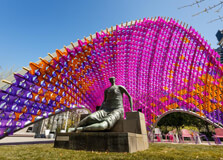
The National Gallery of Victoria (NGV) is Australia’s oldest and most visited art museum. Located in Melbourne, it houses an extensive collection of artworks from around the world, including European, Asian, Oceanic, and Australian art. The NGV is renowned for its dynamic exhibitions, impressive architecture, and commitment to showcasing both historical and contemporary art. How to Reach National Gallery of Victoria, Melbourne By Tram: The closest tram stop is at St Kilda Road, serviced by routes 1, 3, 5, 6, 16, 64, 67, and 72. By Train: Flinders Street Station is a short walk from the gallery. By Bus: Various bus routes connect to St Kilda Road. By Car: Paid parking is available nearby, including at Arts Centre Melbourne. Weather in Melbourne Melbourne has a temperate climate with four distinct seasons: Summer (December-February): Warm temperatures between 14-30°C (57-86°F). Autumn (March-May): Mild and pleasant with temperatures around 10-25°C (50-77°F). Winter (June-August): Cool with temperatures between 6-15°C (43-59°F). Spring (September-November): Variable weather, ranging from cool to warm. Timings of the National Gallery of Victoria The NGV is open daily: Opening Hours: 10:00 AM - 5:00 PM Closed on: Good Friday and Christmas Day Why is the National Gallery of Victoria Famous? The NGV is renowned for its vast and diverse collection, which includes works by renowned artists such as Picasso, Rembrandt, Monet, and Van Gogh. The gallery also hosts international exhibitions, contemporary installations, and cultural events that attract millions of visitors every year. Entry and Visit Details General Admission: Free Special Exhibitions: May require a paid ticket Guided Tours: Available for free and paid exhibitions History and Architecture The NGV was founded in 1861, making it Australia’s oldest public art gallery. The current building, designed by architect Roy Grounds, opened in 1968. Its most iconic feature is the Great Hall’s stained-glass ceiling, one of the largest in the world. Things to Do Explore the Permanent Collection: View artworks from various cultures and time periods. Attend Special Exhibitions: Experience temporary exhibitions from world-famous artists. Enjoy the Great Hall: Relax under the mesmerizing stained-glass ceiling. Visit the NGV Design Store: Shop for unique art-inspired gifts. Experience Interactive Installations: Participate in hands-on activities and workshops. Facts about the NGV The NGV hosts over 3 million visitors annually. It has two sites: NGV International on St Kilda Road and NGV Australia at Federation Square. The gallery’s collection includes over 75,000 artworks. Tips for Visiting Arrive early to avoid crowds, especially on weekends. Check the NGV website for current exhibitions and events. Wear comfortable shoes, as the gallery is large. Visit the café for a relaxing break during your tour.
Explore More
Flinders Street Station is one of Melbourne’s most iconic landmarks. As the busiest railway station in the city, it serves as a central hub for transport and a significant historical site. The station’s unique architecture, grand entrance, and famous clocks make it a must-visit attraction in Melbourne. How to Reach Flinders Street Station, Melbourne By Train: The station is a major railway hub and is served by all metropolitan train lines. By Tram: Numerous tram routes, including the free City Circle tram, stop near the station. By Bus: Several bus routes operate near the station. By Car: Parking is available in nearby areas, but public transport is recommended. By Walking: Located in the heart of Melbourne, it is easily accessible on foot. Weather in Melbourne Melbourne’s weather is highly variable: Summer (December-February): Warm, with temperatures between 14-30°C (57-86°F). Autumn (March-May): Mild, with temperatures around 10-25°C (50-77°F). Winter (June-August): Cool, with temperatures ranging from 6-15°C (43-59°F). Spring (September-November): Pleasant with mild to warm temperatures. Timings of Flinders Street Station Opening Hours: 24/7 as it is an active railway station. Visitor Hours: Public access to the station and concourse is open during train operation hours. Why is Flinders Street Station Famous? The station is famous for its distinctive yellow façade and green dome, its historical significance, and its status as a cultural meeting point in Melbourne. The station’s clocks above the entrance are a well-known rendezvous point for locals. Entry and Visit Details General Admission: Free Guided Tours: Occasionally available for historical insights. Photography: Allowed, but access to certain areas may be restricted. History and Architecture Opened in 1910, Flinders Street Station was Australia’s first railway station. Its Edwardian Baroque architecture features a large dome, arched entrances, and an iconic clock tower. It remains one of Melbourne’s most photographed landmarks. Things to Do Admire the Architecture: Take in the stunning design and historic details. Visit the Historic Clocks: The row of clocks above the entrance is a famous attraction. Explore Federation Square: Located just opposite the station. Walk along the Yarra River: Enjoy scenic views and nearby cafes. Photograph the Station: Capture its beauty, especially at night. Facts about Flinders Street Station The station sees over 100,000 passengers daily. It was once home to a ballroom, which remains closed to the public. The design was based on a competition-winning plan in 1899. Tips for Visiting Visit during off-peak hours for a quieter experience. Look out for street performers and artists nearby. Use the station as a starting point to explore Melbourne’s key attractions. Check for occasional events or historical tours.
Explore More
Eureka Tower is one of the tallest buildings in Melbourne and offers breathtaking panoramic views of the city. The skyscraper, standing at 297 meters, features an observation deck known as the Skydeck, making it a must-visit attraction for tourists. How to Reach Eureka Tower, Melbourne By Train: Flinders Street Station is the closest railway station, a short walk from the tower. By Tram: Multiple tram routes stop near Eureka Tower, including routes along St Kilda Road. By Car: Paid parking is available at nearby parking facilities. By Walking: Easily accessible from Melbourne CBD and the Yarra River precinct. Weather in Melbourne Melbourne’s weather is unpredictable, but generally follows these trends: Summer (December-February): Warm, 14-30°C (57-86°F). Autumn (March-May): Mild, 10-25°C (50-77°F). Winter (June-August): Cool, 6-15°C (43-59°F). Spring (September-November): Pleasant, mild to warm temperatures. Timings of Eureka Tower Skydeck Opening Hours: 12:00 PM - 10:00 PM (last entry at 9:30 PM). General Building Access: Open daily for office and residential use. Why is Eureka Tower Famous? Eureka Tower is renowned for its height, gold-plated windows, and stunning 360-degree views of Melbourne. The Skydeck, located on the 88th floor, is the highest public observation deck in the Southern Hemisphere. Entry and Visit Details General Admission: Ticketed entry to the Skydeck. The Edge Experience: A glass cube that extends out from the tower for a thrilling view. Photography: Allowed, offering some of the best cityscapes. History and Architecture Completed in 2006, Eureka Tower was designed by Fender Katsalidis Architects. The building’s gold-tinted windows symbolize the gold rush era, while the red stripe represents the blood shed during the Eureka Stockade rebellion. Things to Do Visit the Skydeck: Enjoy stunning city views. Experience The Edge: Step into a glass cube for a thrilling perspective. Explore the Surrounding Area: Walk along the Yarra River and visit nearby attractions. Enjoy Fine Dining: Visit Eureka 89 for a luxurious dining experience. Facts about Eureka Tower It has 92 floors, making it one of the tallest residential buildings in the world. The gold-plated windows reflect the building’s name, derived from the Eureka Stockade. The Skydeck is 285 meters above ground level. Tips for Visiting Visit at sunset for the best views. Book tickets in advance to avoid long queues. Wear comfortable shoes for exploring nearby attractions.
Explore More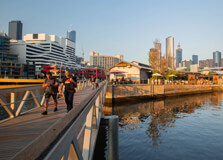
Southbank Promenade is a lively waterfront precinct in Melbourne, known for its scenic views, dining experiences, and vibrant cultural atmosphere. Stretching along the Yarra River, it offers visitors a perfect blend of leisure, entertainment, and stunning cityscapes. How to Reach Southbank Promenade, Melbourne By Train: Flinders Street Station is the nearest railway station, just a short walk away. By Tram: Several tram routes service the area, including stops along St Kilda Road and Swanston Street. By Car: Paid parking is available at nearby parking garages. By Walking: Easily accessible from Melbourne CBD via pedestrian bridges. Weather in Melbourne Melbourne’s weather varies, with four distinct seasons: Summer (December-February): Warm, 14-30°C (57-86°F). Autumn (March-May): Mild, 10-25°C (50-77°F). Winter (June-August): Cool, 6-15°C (43-59°F). Spring (September-November): Pleasant with occasional rain. Timings of Southbank Promenade Southbank Promenade is open 24/7, but individual restaurants, cafes, and attractions have their own operating hours. Why is Southbank Promenade Famous? Southbank Promenade is famous for its vibrant nightlife, fine dining options, arts and cultural hubs like the Arts Centre Melbourne, and picturesque riverside views. It’s a hub for both locals and tourists. Entry and Visit Details Entry: Free access to the promenade. Attractions: Various paid and free experiences, including Crown Casino, street performances, and gallery visits. History and Architecture Southbank was transformed in the 1990s from an industrial area into a modern entertainment and cultural precinct. It features contemporary urban design with pedestrian-friendly walkways and public art installations. Things to Do Walk along the River: Enjoy scenic views of the Yarra River. Dine at World-Class Restaurants: Experience fine dining at restaurants like Nobu and Dinner by Heston. Visit the Arts Precinct: Explore venues like the National Gallery of Victoria and the Melbourne Theatre Company. Experience Crown Casino: A world-class casino and entertainment complex. Facts about Southbank Promenade Home to Melbourne’s tallest buildings, including Eureka Tower. Hosts various annual events, including the Moomba Festival and New Year’s Eve fireworks. The Southbank Pedestrian Bridge connects the promenade to Flinders Street Station. Tips for Visiting Visit in the evening to experience the city lights and lively atmosphere. Book restaurant reservations in advance for fine dining experiences. Explore the local street performances and public art installations.
Explore More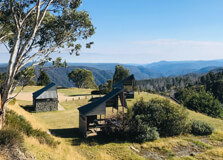
Cabramurra Lookout is a stunning viewing point located in the Snowy Mountains of New South Wales, Australia. Positioned near what was once Australia's highest town — Cabramurra — the lookout offers breathtaking panoramic views of the surrounding alpine landscape, including deep valleys, forested ridges, and parts of the Snowy Hydro infrastructure. It’s a spot that beautifully captures the essence of the Snowy Mountains, combining natural beauty with a touch of engineering history. Though Cabramurra town itself was permanently closed to residents in 2015 and suffered damage in the 2020 bushfires, the lookout area remains a popular stop for travelers exploring Kosciuszko National Park and the Snowy Mountains region. Cabramurra Lookout stands as a reminder of the area’s unique blend of natural and man-made marvels. How to Reach Cabramurra Lookout, Cabramurra Cabramurra Lookout is accessible via the Snowy Mountains Highway. The lookout lies within the Kosciuszko National Park, and the nearest major towns are Tumut, Cooma, and Adaminaby. From Tumut, the drive to the lookout takes about 1.5 to 2 hours. From Cooma, it’s around a 2-hour drive via the Snowy Mountains Highway and Link Road. While the road to the lookout is sealed and suitable for most vehicles in summer, it is essential to check for seasonal road closures and weather conditions, especially during winter when snow and ice can make travel difficult or unsafe. Road access may also be temporarily restricted due to bushfire recovery work or park maintenance. Weather in Cabramurra and the Lookout Area Cabramurra and its surrounding regions experience an alpine climate, meaning cold winters and cool summers. During winter months (June to August), the area can receive significant snowfall, and temperatures often drop below freezing. Snowfall creates a serene white landscape, although access can be restricted. In summer (December to February), temperatures are mild, generally ranging between 10°C to 20°C, making it the ideal time for sightseeing and enjoying the lookout views. Weather can change rapidly in alpine areas, so visitors are advised to wear layered clothing and be prepared for sudden shifts in temperature or rainfall. Timing The Cabramurra Lookout is accessible year-round, though the best time to visit is during the warmer months, from late November to early April. During this time, the roads are generally clear of snow, visibility is high, and the lush alpine vegetation is at its most vibrant. If you're planning a winter visit, be sure to check local conditions for snow warnings and road closures. Early mornings and late afternoons provide the best lighting for photography and sightseeing. Why is Cabramurra Famous? Cabramurra was once the highest permanently inhabited town in Australia, sitting at 1,488 meters above sea level. It was established in the 1950s to house workers involved in the Snowy Mountains Hydro-Electric Scheme, one of Australia’s most significant engineering feats. The town was notable not just for its altitude, but also for its role in powering the nation and helping with inland irrigation. Cabramurra symbolized Australia's post-war development and multicultural labor effort, involving workers from more than 30 countries. Though now uninhabited, the town and its surroundings — including the Cabramurra Lookout — remain culturally and historically significant. Entry and Visit Details about Cabramurra Lookout Cabramurra Lookout is located within Kosciuszko National Park, which requires an entry fee. Vehicle entry fees are approximately AUD $17 per day in summer and AUD $29 in winter. Entry passes can be obtained at park gates or through the NSW National Parks website. There are no facilities directly at the lookout, so visitors should bring their own water, snacks, and supplies. Toilets and parking areas may be found at nearby visitor sites or picnic spots within the park. It’s also important to follow park rules, stay on designated paths, and respect any signs indicating restricted areas. History and Architecture The history of the Cabramurra area is tied closely to the Snowy Mountains Hydro-Electric Scheme, launched in 1949. The scheme included the construction of dams, tunnels, and power stations, and required a network of towns to support the thousands of workers involved. Cabramurra was one of those towns, designed with practical architecture to withstand alpine conditions. Although much of Cabramurra was damaged during the 2020 bushfires and many original buildings no longer stand, the area retains a sense of historical significance. The lookout provides a vantage point to appreciate the scale and impact of the hydro project, as well as the rugged beauty of the Snowy Mountains. Things to Do at Cabramurra Lookout The lookout and surrounding area offer a range of relaxing and outdoor activities: Scenic Viewing: Enjoy panoramic views of the Snowy Mountains, forests, and valleys below. Photography: The elevated position is perfect for capturing dramatic landscapes and alpine skies. Wildlife Spotting: The surrounding national park is home to wombats, kangaroos, and a variety of alpine birds. Bushwalking: Explore nearby walking trails in the national park for an immersive nature experience. Historical Insight: Learn about the Snowy Hydro Scheme and the engineering legacy of Cabramurra through interpretive signs in the area. Facts and Tips about Cabramurra Lookout Interesting Facts: Cabramurra was the highest permanently inhabited town in Australia before its closure. The lookout provides views of part of the Tumut Pond Dam, a key feature of the hydro-electric scheme. The Snowy Mountains region has more than 20 alpine species found nowhere else in Australia. Travel Tips: Bring binoculars for a better view of distant peaks and wildlife. Check weather conditions and park alerts before visiting, especially in winter months. Carry enough fuel, water, and food as services are limited in remote areas. Respect nature and stay on marked paths to avoid disturbing sensitive alpine ecosystems. Visit during golden hours (sunrise or sunset) for the most dramatic lighting and best photos.
Explore More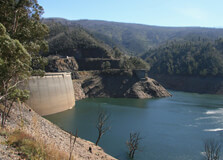
Tumut Pond Dam is a major hydro-electric structure located near Cabramurra in the Snowy Mountains region of New South Wales, Australia. As part of the Snowy Mountains Hydro-Electric Scheme, this dam plays a crucial role in both power generation and water management. Surrounded by stunning alpine scenery and deep gorges, Tumut Pond Dam is an engineering marvel set in one of Australia’s most beautiful highland landscapes. Situated not far from the former town of Cabramurra, the dam is a key site in understanding the significance of the hydro-electric scheme that helped modernize Australia in the post-war era. Today, it attracts both engineering enthusiasts and nature lovers who want to explore its rugged beauty and historic relevance. How to Reach Tumut Pond Dam, Cabramurra Tumut Pond Dam can be reached by road via the Snowy Mountains Highway and Cabramurra Road. The nearest major towns include Tumut (about 2 hours away by car) and Cooma (approximately 2.5 hours away). From Cabramurra, which is currently uninhabited but still serves as a reference point, the dam is accessible via Link Road. The route is scenic but remote, so visitors should ensure their vehicle is in good condition, carry extra fuel, and check road conditions, especially during winter when snow and ice may make roads impassable. Mobile coverage is limited in the area, so having a physical map or GPS device is highly recommended. Weather in Tumut Pond Dam Area The weather around Tumut Pond Dam is typical of an alpine region. Winters (June to August) are cold, often with snow and icy conditions. Daytime temperatures can fall below zero, making it important for winter travelers to dress warmly and drive cautiously. In summer (December to February), the climate is much milder, with temperatures ranging from 10°C to 25°C. The best time to visit for sightseeing and outdoor activities is during late spring to early autumn (November to April), when conditions are more stable and the surrounding bushland is green and vibrant. Timing Tumut Pond Dam is accessible year-round, but the best visiting experience is during the warmer months. Summer and early autumn offer clear skies and more comfortable temperatures for walking around the dam area and enjoying the views. It is recommended to visit during daylight hours, as the roads can be challenging to navigate in the dark, and there is limited lighting or infrastructure in the immediate area. Early mornings and late afternoons are ideal for photography due to the lighting on the water and mountains. Why is Cabramurra Famous? Cabramurra was once Australia’s highest permanently inhabited town, located at 1,488 meters above sea level. Built in the 1950s as a residential center for workers on the Snowy Mountains Hydro-Electric Scheme, Cabramurra became a symbol of national progress, technological ambition, and multicultural cooperation. Although the town is now closed to residents and was damaged in the 2020 bushfires, it remains historically important as a central hub during the development of one of the largest and most complex hydroelectric and irrigation schemes in the world. Entry and Visit Details about Tumut Pond Dam Tumut Pond Dam lies within Kosciuszko National Park, so a park entry fee is applicable. For vehicles, the fee is around AUD $17 per day in summer and AUD $29 during the winter season. Entry passes can be purchased at park gates or online via the New South Wales National Parks website. There are no ticket booths or visitor centers directly at the dam. Basic facilities such as parking and signage may be available, but travelers are encouraged to come prepared with their own water, food, and emergency supplies. Be sure to check weather and safety alerts before traveling to the area. History and Architecture Tumut Pond Dam was completed in 1959 and is a concrete arch dam that impounds the Tumut River. It is a key part of the Tumut development of the Snowy Mountains Scheme and serves to divert water through a tunnel system to underground power stations such as Tumut 1 and Tumut 2. The dam is 86 meters high and 218 meters long. Its reservoir, known as Tumut Pond Reservoir, holds over 52,000 megalitres of water. The architectural design is both functional and impressive, showcasing mid-20th century engineering and construction techniques tailored to the rugged mountain landscape. Things to Do at Tumut Pond Dam While Tumut Pond Dam is not a commercial tourist attraction, it offers several rewarding activities for outdoor and nature enthusiasts: Sightseeing: Enjoy the striking contrast between the concrete dam and the natural alpine environment. Photography: Capture panoramic shots of the dam, the reservoir, and surrounding mountain peaks. Bushwalking: Explore walking trails and lookouts nearby for immersive nature experiences. Birdwatching: Spot native bird species and alpine wildlife in the surrounding national park. Educational Visit: Learn about Australia’s hydroelectric history and environmental management through signage and research. Facts and Tips about Tumut Pond Dam, Cabramurra Interesting Facts: Tumut Pond Dam supplies water to the Tumut Hydroelectric System, which produces a significant portion of NSW’s hydroelectric power. The dam was built as part of a national effort involving over 100,000 workers from more than 30 countries. The Snowy Mountains Scheme is considered one of the seven engineering wonders of the modern world (according to Engineers Australia). Travel Tips: Carry a printed map or download maps offline — GPS signals can be weak or nonexistent. Visit during summer or early autumn for the best road conditions and views. Check the official NSW National Parks website for up-to-date alerts and road closures before your trip. Respect signage and barriers, as the dam is still an active hydro facility with safety protocols in place. There are limited facilities nearby, so bring all necessary food, water, and emergency supplies.
Explore More
Selwyn Snow Resort is a family-friendly ski destination located in the Snowy Mountains of New South Wales, Australia. Situated near the town of Cabramurra, the highest town in Australia, Selwyn offers a range of snow activities suitable for all ages and skill levels. The resort is renowned for its welcoming atmosphere, making it an ideal choice for families and beginners seeking an authentic alpine experience. How to Reach Selwyn Snow Resort, Cabramurra To reach Selwyn Snow Resort, travelers can drive from Canberra, which is approximately a 2.5-hour journey. From Canberra, take the Snowy Mountains Highway towards Cooma, then follow the signs to Cabramurra. The resort is located within the Kosciuszko National Park, so visitors should be prepared for mountain driving conditions. It's essential to check road conditions before traveling, as some roads may be closed during winter months due to snow and ice. Additionally, from June to October long weekends, all vehicles entering Kosciuszko National Park must carry snow chains. These can be hired at most service stations along the way. Weather and Timing The weather at Selwyn Snow Resort is typical of an alpine environment. Winters (June to August) are cold, with temperatures often dropping below freezing and snowfall common. The resort typically opens in early June and operates through the October long weekend, depending on snow conditions. It's advisable to check the resort's official website or contact the Tumut Region Visitor Centre for the latest information on opening dates and snow conditions before planning your visit. Why Is Cabramurra Famous? Cabramurra holds historical significance as the highest town in Australia, situated at an elevation of 1,481 meters. Established in 1954 as part of the Snowy Mountains Scheme, the town served as a base for workers involved in the hydro-electric project. The town's unique architecture, designed to withstand heavy snowfall, and its role in Australia's engineering history contribute to its fame. Entry and Visit Details about Selwyn Snow Resort Selwyn Snow Resort is located within the Kosciuszko National Park, and as such, park entry fees apply. From June to October long weekends, the vehicle entry fee is $29 per day. Passes can be purchased at entry stations, NPWS visitor centres, pay machines, or via the Park'nPay app. It's important to note that some roads and trails in the Selwyn area may close due to weather conditions or park management issues during winter months. History and Architecture The origins of Selwyn Snow Resort trace back to nearby Kiandra, where skiing began in Australia around 1861. The more reliable snow cover at Selwyn led to the establishment of a portable rope tow in 1966. Over the years, the resort has evolved, with significant developments including the installation of a triple chairlift in 2009. Unfortunately, the resort was heavily impacted by the 2019–2020 bushfires, leading to the loss of many facilities. However, it has since been rebuilt and reopened in 2023, offering modern amenities and improved infrastructure. Things to Do at Selwyn Snow Resort Selwyn Snow Resort offers a variety of activities for visitors: Skiing and Snowboarding: The resort provides slopes suitable for all skill levels, with 88% of terrain catering to beginners and intermediates. The longest run is the 800m Long Arm Run. Tobogganing: Enjoy Australia's largest dedicated toboggan park, featuring a 150-meter snow carpet. Snow Tubing and Snow Shoeing: Experience the thrill of snow tubing or explore the snowy landscape on snowshoes. Cross-Country Skiing: The resort offers 45 kilometers of marked cross-country trails for enthusiasts. Dining and Relaxation: The Selwyn Centre houses all guest facilities, including dining options where visitors can enjoy hot chocolate and meals with views of Mount Jagungal and Tabletop. Facts and Tips about Selwyn Snow Resort Interesting Facts: Selwyn Snow Resort is the most northerly of Australia's ski resorts, with a base elevation of 1,492 meters and a top elevation of 1,614 meters. The resort's snowmaking area covers 35 hectares, ensuring consistent snow conditions throughout the season. Selwyn traces its origins to Kiandra, where skiing began in Australia in 1861. Travel Tips: Always check road conditions before traveling, as weather can change rapidly in alpine areas. Ensure your vehicle is equipped with snow chains during winter months, as required by park regulations. Dress in layers and wear waterproof clothing to stay comfortable in cold and wet conditions. Stay hydrated and take regular breaks to prevent fatigue, especially when engaging in snow activities. Respect all safety signs and instructions provided by resort staff to ensure a safe experience.
Explore More
The Sea Cliff Bridge is one of the most iconic landmarks in the Wollongong region, located in New South Wales, Australia. Stretching across the Pacific Ocean, this stunning bridge offers some of the most spectacular coastal views in the country. The bridge, which is part of the Lawrence Hargrave Drive, provides a unique experience for both drivers and pedestrians as they cross over the ocean on a cantilevered structure that hugs the cliffs. With its architectural elegance and natural beauty, the Sea Cliff Bridge has become a must-visit spot for tourists, photographers, and locals alike. How to Reach Sea Cliff Bridge, Wollongong The Sea Cliff Bridge is located approximately 15 kilometers north of Wollongong, making it easily accessible for both visitors staying in the city and those coming from further afield. The bridge is situated along Lawrence Hargrave Drive, which runs parallel to the coastline and provides a scenic route leading directly to the bridge. If you are driving from Wollongong, take the Princes Highway (A1) and follow the signs towards the northern beaches, passing through the suburbs of Stanwell Park and Coalcliff. Alternatively, public transport options are available via train or bus to the nearby stations, and you can walk or take a short bus ride to the bridge. For those arriving by car, there is ample parking at both ends of the bridge, allowing visitors to stop, take in the views, and explore the surrounding area. Weather and Timing The weather in the Wollongong region can vary, but it generally enjoys a mild coastal climate. Summer (December to February) temperatures range between 22°C and 30°C, while winter (June to August) is cooler, with temperatures ranging from 8°C to 18°C. Due to its coastal location, the weather can change quickly, so visitors are advised to check the forecast before heading out. The Sea Cliff Bridge can be visited year-round, but the best times to experience its stunning views are during the spring (September to November) and autumn (March to May), when the weather is mild and the landscape is vibrant. The bridge is particularly popular at sunrise and sunset, offering beautiful views of the ocean and the cliffs. However, if you’re visiting during peak tourist seasons, it’s best to come early in the morning or later in the evening to avoid large crowds. Why is Sea Cliff Bridge Famous for Wollongong? Sea Cliff Bridge is famous for its breathtaking views, unique design, and its role in improving the safety of the coastal road. The bridge was built to replace the old, narrow, and often dangerous route along the coastline that was prone to landslides and rockfalls. Its construction was part of a larger initiative to upgrade Lawrence Hargrave Drive and improve transportation access to the Illawarra region. The Sea Cliff Bridge has become a popular tourist attraction, attracting photographers, nature lovers, and people seeking to experience its exceptional coastal views. The design of the bridge, which seems to float above the ocean, is a remarkable feat of engineering, and it has won numerous awards for its aesthetics and environmental design. It is often described as one of the most picturesque drives in Australia, and its scenic beauty is a major reason why it is so well-known in the Wollongong region. Entry and Visit Details about Sea Cliff Bridge, Wollongong The Sea Cliff Bridge is free to visit, and there are no entry fees for pedestrians or vehicles. Visitors can walk along the designated pedestrian pathway that runs alongside the bridge, offering unparalleled views of the Pacific Ocean and the surrounding cliffs. The pedestrian pathway allows you to safely stop and take photographs, making it an excellent opportunity for sightseeing and photography. There are designated parking areas at both ends of the bridge, where visitors can park their cars and take time to enjoy the surrounding landscape. The bridge is open to the public year-round, and there are no restrictions on visiting hours. However, it’s advisable to be cautious while walking near the edges of the bridge, as the road can sometimes be busy, especially during peak tourist seasons. History and Architecture of Sea Cliff Bridge The Sea Cliff Bridge was completed in 2005 and represents a significant achievement in modern engineering and environmental design. The bridge was constructed to replace a section of Lawrence Hargrave Drive that had become unstable due to frequent rockfalls and landslides. The new bridge spans 665 meters and is an engineering marvel that features a unique cantilevered design that allows it to float above the ocean. The bridge's structure is made of steel and concrete, and it was designed to blend in harmoniously with its surroundings. The design was chosen to minimize the impact on the environment while maintaining the safety and functionality of the road. The Sea Cliff Bridge is considered an architectural masterpiece, as it combines practicality with stunning visual appeal. The bridge has won multiple awards, including the prestigious Australian Engineering Excellence Award. Things to Do at Sea Cliff Bridge, Wollongong Visitors to the Sea Cliff Bridge will find plenty of things to do while enjoying the stunning coastal views and the natural beauty of the surrounding area. Here are some of the top activities to enjoy: Photography: The Sea Cliff Bridge offers one of the most picturesque views in Australia, making it a perfect spot for photography. Whether you’re capturing the bridge at sunrise or sunset, the views are truly breathtaking. Walking and Exploring: Take a leisurely stroll along the pedestrian pathway that runs parallel to the bridge. The pathway provides spectacular views of the ocean, cliffs, and the surrounding area, making it a perfect place for nature walks. Enjoy Scenic Drives: Lawrence Hargrave Drive is a popular route for those seeking a scenic drive along the coast. The road features several lookouts where visitors can stop and take in the views. Whale Watching: During the migration season (May to November), the area around the Sea Cliff Bridge is a popular spot for whale watching. From the bridge, you may be able to spot humpback whales and other marine life as they pass by. Relax and Picnic: While there are no formal picnic areas at the bridge itself, visitors can stop at nearby parks and beaches for a relaxing picnic while enjoying the coastal views. Facts and Tips about Sea Cliff Bridge, Wollongong Interesting Facts: The Sea Cliff Bridge is a 665-meter-long cantilevered bridge that spans across the Pacific Ocean. The bridge was completed in 2005 after years of planning and construction, replacing an older, unsafe section of Lawrence Hargrave Drive. It is one of only a few cantilevered bridges in the world that is open to public traffic and pedestrians. The bridge offers views of the coastline, the ocean, and nearby cliffs, making it one of the most scenic drives in Australia. The Sea Cliff Bridge is located in the Illawarra region, which is a popular spot for tourists looking to explore coastal beauty and enjoy outdoor activities. Travel Tips: Arrive early or later in the evening to avoid the busiest times, particularly during weekends and holidays. Take a camera with you to capture the stunning views, especially during sunrise or sunset. If you're visiting during the whale migration season, be sure to keep an eye out for humpback whales. Wear comfortable shoes if you plan to walk along the pedestrian pathway, as it can be a bit steep in places. While visiting the Sea Cliff Bridge is free, consider exploring nearby areas, such as Stanwell Park or the nearby beaches, for a full day out.
Explore More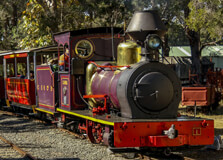
Illawarra Light Railway Museum
The Illawarra Light Railway Museum, located in Wollongong, New South Wales, is a fascinating destination for railway enthusiasts, history buffs, and anyone interested in the rich heritage of Australian rail travel. This museum offers visitors a unique opportunity to explore and experience the history of the Illawarra region’s railway system, with a focus on its light rail network. The museum is home to a variety of vintage locomotives, carriages, and other railway-related artifacts, allowing visitors to step back in time and gain a deeper appreciation for the engineering and history behind one of the region's most vital transport systems. How to Reach Illawarra Light Railway Museum, Wollongong The Illawarra Light Railway Museum is located in the suburb of Albion Park Rail, just a short drive from Wollongong city center. To reach the museum, visitors can take the Princes Highway (A1) heading south from Wollongong. The museum is well-signposted, and there is ample parking available on-site for those driving. The museum is located about a 20-minute drive from Wollongong, making it easily accessible for both locals and tourists. If you prefer public transport, you can take a train to Albion Park Station, which is nearby. From the station, it is only a short walk to the museum. Bus services also operate in the area, making it easy for visitors traveling by public transport to access the museum. Weather and Timing Wollongong, where the Illawarra Light Railway Museum is located, enjoys a temperate climate with warm summers and mild winters. The best time to visit the museum is during the spring and autumn months, from September to November and March to May, as the weather is comfortable, and the crowds are usually smaller. Summer (December to February) is warmer, with temperatures ranging from 20°C to 28°C, while winter (June to August) is cooler, with temperatures ranging from 10°C to 17°C. The museum is open for visits throughout the year, but it’s always a good idea to check its official website or contact the staff for specific hours of operation, especially during public holidays or special events. The museum typically opens on weekends, with special events and exhibitions occasionally hosted on weekdays. Why Illawarra Light Railway Museum is Famous for Wollongong The Illawarra Light Railway Museum is famous for its dedication to preserving and showcasing the region's railway history. It is one of the few museums in Australia that focuses specifically on the history of light rail transport, making it a unique attraction. The museum provides a rare chance to view historical trains and other railway artifacts that were once part of the daily life of local communities. It serves as a reminder of the vital role that trains played in the development of the region and the Australian transport system as a whole. One of the key features that make the museum famous is its working steam and diesel locomotives. Visitors have the opportunity to see these trains in action, as well as learn about the engineering innovations that helped shape the railway industry in Australia. The museum also offers train rides for those looking for an interactive experience, allowing them to ride on heritage trains and experience the charm of historical railway travel. Entry and Visit Details about Illawarra Light Railway Museum Entry to the Illawarra Light Railway Museum is reasonably priced, with discounts available for children, students, and seniors. Visitors are encouraged to check the museum's website or call ahead for up-to-date entry fees, as they may vary depending on the season or special events. There are often special deals and discounts during school holidays and other promotional periods. The museum is open on weekends, typically from 10:00 AM to 4:00 PM, and on certain public holidays. It is also advisable to check for special train ride schedules, as these are available on certain days throughout the year. Group tours are available, and it’s a great place for educational visits, particularly for school groups interested in learning about the history of transport in Australia. History and Architecture of Illawarra Light Railway Museum The Illawarra Light Railway Museum has its roots in the preservation of the region’s railway history. The museum was established in 1987 by the Wollongong Division of the New South Wales Rail Transport Museum. The museum is located on land that was once part of the Albion Park Railway Station, which was an important stop on the Illawarra Railway line. The museum itself occupies a charming site that features a variety of old railway buildings, including a former station building and a working depot. The collection includes a range of railway vehicles, including vintage trains, locomotives, carriages, and other historical transport equipment. The architecture of the site reflects its historical significance, with structures that retain much of their original charm and character. Things to Do at Illawarra Light Railway Museum The Illawarra Light Railway Museum offers a range of activities and experiences for visitors of all ages. Some of the things to do at the museum include: Train Rides: One of the highlights of the museum is the opportunity to ride on heritage trains. Visitors can enjoy short train rides around the site, experiencing the thrill of a vintage steam or diesel locomotive in action. Explore Exhibits: The museum features a wide range of exhibits, including old locomotives, carriages, signage, and other railway artifacts. You can take a leisurely stroll through the museum and discover the history of the Illawarra Light Railway network. Learn About Railway History: The museum offers detailed information about the history of trains in the Illawarra region, showcasing the impact of rail transport on local communities and industries. Attend Special Events: The museum often hosts special events, such as heritage train rides, steam festivals, and educational talks about the history of Australian rail transport. These events are a great way to get a deeper understanding of the railway’s cultural and historical significance. Shop for Memorabilia: The museum’s gift shop offers a range of railway-related memorabilia, including model trains, books, and other items that make perfect souvenirs for visitors. Facts and Tips about Illawarra Light Railway Museum Interesting Facts: The museum is home to a unique collection of vintage trains and locomotives, many of which were used in the Illawarra region. It is one of the few railway museums in Australia dedicated to preserving the history of light rail transport. Visitors can take a ride on a fully operational heritage steam train, which is a rare experience in modern-day Australia. The museum’s location, near the original Albion Park Railway Station, adds to the authenticity and historical charm of the site. Travel Tips: Check the museum’s website or contact them for information about special events or train ride schedules before your visit. Wear comfortable footwear, as there is a fair amount of walking involved when exploring the exhibits. If visiting with children, be sure to check for family-friendly activities or educational programs that are available during your visit. Consider visiting on weekends or during school holidays to take advantage of the special train rides offered by the museum.
Explore More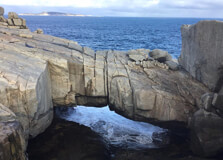
The Gap and Natural Bridge are two of the most stunning natural attractions in Albany, Western Australia. Located in the Torndirrup National Park, they showcase the incredible power of nature in shaping the landscape over millions of years. The Gap is a deep, dramatic chasm in the rocks where the ocean crashes violently against the shore, while the Natural Bridge is a remarkable rock formation that has been carved out by the forces of wind and water. Together, these two sites offer visitors some of the most spectacular coastal views in Australia. How to Reach The Gap and Natural Bridge, Albany The Gap and Natural Bridge are located approximately 15 kilometers from the center of Albany. To get there, you can drive via Frenchman Bay Road, which is well signposted. The drive takes around 20 minutes from Albany's city center. If you're coming from Perth, Albany is about a 4.5-hour drive south, or a short flight from Perth to Albany Airport followed by a short drive to the sites. The area is accessible by car, and there is ample parking available near the viewing platforms for both The Gap and the Natural Bridge. Weather and Best Time to Visit Albany experiences a temperate climate, with warm summers and mild winters. The summer months (December to February) see temperatures ranging from 16°C to 26°C, while winter (June to August) has temperatures between 8°C and 18°C. Due to the coastal location of The Gap and Natural Bridge, it’s advisable to visit in spring or autumn when the weather is mild and the area is less crowded. However, the winter months also offer a dramatic experience as the seas tend to be rougher, making the waves even more spectacular at The Gap. Timing and Entry Details The Gap and Natural Bridge are open to visitors year-round and are free to access. There is no formal entry fee, but donations are welcome to support the preservation of the site. The viewing platforms are accessible at all hours, but the best times to visit are during daylight hours to fully appreciate the views and safety of the walkways. The area is generally open from 8:00 AM to 6:00 PM, with extended hours during peak summer months. Why The Gap and Natural Bridge Are Famous for Albany The Gap and Natural Bridge are famous for their breathtaking natural beauty and geological significance. The Gap is particularly known for its intense waves crashing through the gap in the rocks, creating a stunning spectacle. The Natural Bridge, on the other hand, is an extraordinary rock formation that seems to defy nature, creating a perfect archway over the ocean. These sites are iconic in Albany, drawing visitors from all over the world to experience the raw power of the Southern Ocean and the geological marvels of the coastline. History and Architecture of The Gap and Natural Bridge The Gap and Natural Bridge are natural formations that have been sculpted by the relentless forces of wind, water, and time. Over millions of years, the ocean has worn away the rock at these sites, creating the unique features we see today. The Natural Bridge is a testament to the strength of erosion, as it has gradually carved out a massive arch in the rock. The Gap, a deep chasm, has formed due to the constant pounding of the Southern Ocean’s waves against the cliff faces. There is no architectural structure here, as it is purely a result of nature’s processes. Things to Do at The Gap and Natural Bridge There are several activities you can enjoy while visiting The Gap and Natural Bridge: Walking and Viewing: The main activity at these sites is walking along the well-maintained pathways and viewing platforms that offer panoramic views of the ocean and the surrounding landscape. Photography: The stunning natural scenery is perfect for photography. Whether you're capturing the dramatic cliffs, the crashing waves, or the picturesque rock formations, there’s no shortage of beautiful shots. Wildlife Spotting: Keep an eye out for local wildlife. The area is home to various bird species, including seabirds and raptors, which can often be seen soaring over the cliffs. Picnicking: There are picnic areas around the park where you can relax and enjoy the spectacular surroundings while having a snack or meal. Facts About The Gap and Natural Bridge Here are some interesting facts about The Gap and Natural Bridge: The Gap is part of the Torndirrup National Park, which is named after a local Noongar Aboriginal word meaning "place of the sea". The Gap’s chasm is approximately 25 meters deep, with the Southern Ocean's waves crashing against the rocks below, creating a dramatic sound and sight. The Natural Bridge is a rock formation that is over 100 million years old, shaped by natural forces over time. Both The Gap and Natural Bridge are prime spots for whale watching during the migration season (June to October). Tips for Visiting The Gap and Natural Bridge Here are some helpful tips for your visit: Wear sturdy footwear: While the paths are well-maintained, some areas can be rocky, so it’s important to wear comfortable, non-slip shoes. Bring a camera: The views from the platforms are incredible, so be sure to bring a camera or smartphone to capture the beauty of the landscapes. Check the weather: The coastal weather can change rapidly, so it’s advisable to check the forecast before your visit. On windy or rainy days, the waves at The Gap can be particularly spectacular. Respect the natural environment: The area is a protected park, so make sure to follow all posted signs, stay on the paths, and dispose of rubbish responsibly to preserve the environment. Conclusion The Gap and Natural Bridge are two of Albany’s most stunning natural attractions. Offering dramatic views, unique geological formations, and a serene atmosphere, they are must-visit spots for anyone traveling to the area. Whether you’re a nature lover, a photographer, or simply someone looking to experience the beauty of the Southern Ocean, these sites are sure to leave you in awe. So, pack your bags and make sure to include The Gap and Natural Bridge in your Albany itinerary!
Explore More
The Albany Wind Farm is one of the most impressive renewable energy landmarks in Australia. Located on the cliffs of the Torndirrup National Park, the wind farm boasts breathtaking views of the Southern Ocean and the rugged coastline. As one of the largest wind farms in the Southern Hemisphere, it not only produces clean energy but also serves as a popular tourist attraction. The 18 towering wind turbines that dot the landscape make this site a must-see for visitors to Albany, particularly for those with an interest in sustainability and renewable energy. How to Reach Albany Wind Farm, Albany Reaching the Albany Wind Farm is quite simple, as it is located just a short 20-minute drive from the center of Albany, about 12 kilometers to the west. To get there, follow Frenchman Bay Road, which will take you straight to the wind farm site. The road is well-marked, and once you arrive, there is ample parking available at the site for visitors. If you're staying in Albany, it’s a quick and easy drive that also offers scenic views along the way. Weather and Best Time to Visit Albany enjoys a temperate climate, which makes it a great place to visit year-round. Summer temperatures range between 16°C and 26°C, while winter temperatures are between 8°C and 18°C. The best time to visit the Albany Wind Farm is during the spring and autumn months when the weather is mild and the winds are perfect for the turbines to generate energy. However, visiting in the summer can provide you with warmer temperatures, while winter offers a chance to experience the dramatic coastal views with rougher seas and winds, making the landscape even more awe-inspiring. Timing and Entry Details The Albany Wind Farm is open to the public year-round, and visitors can explore the site at any time of day. While the wind farm itself is free to visit, the viewing platforms and walking trails provide the best experience of the area. The viewing area is accessible during daylight hours, but it is advisable to visit between 8:00 AM and 6:00 PM, especially if you want to take advantage of the beautiful natural light for photography or simply to enjoy the landscape. There is no entry fee to visit the wind farm, but donations to help with the maintenance of the site are welcome. Why Albany Wind Farm is Famous for Albany The Albany Wind Farm is famous not only for its role in generating renewable energy but also for its incredible location and the stunning views it provides. It is one of the largest wind farms in Australia, consisting of 18 wind turbines that are capable of generating enough electricity to power thousands of homes. The combination of the farm's clean energy production and its breathtaking location on the cliffs overlooking the Southern Ocean makes it a popular stop for both environmental enthusiasts and tourists looking to enjoy spectacular views. The farm also represents a significant commitment to sustainability and environmental conservation, which has made it a model for renewable energy projects around the country. History and Architecture of Albany Wind Farm The Albany Wind Farm was officially opened in 2001 and remains a significant part of Australia’s efforts to harness renewable energy. The wind farm was designed to harness the strong and consistent winds of the Southern Ocean to generate electricity. The 18 wind turbines, each standing 67 meters tall, are strategically placed to capture the best wind conditions and convert them into clean, sustainable power. The architecture of the wind farm is simple yet striking, with sleek, modern turbines standing tall against the backdrop of Albany's dramatic coastline. The turbines themselves are state-of-the-art, designed to be highly efficient and environmentally friendly, contributing to reducing the carbon footprint of the region. The design and placement of the turbines are carefully considered to minimize environmental disruption while maximizing energy production. Things to Do at Albany Wind Farm There are plenty of activities you can enjoy while visiting the Albany Wind Farm. Here are some of the top things to do: Walking Trails: The wind farm is surrounded by several walking trails that allow visitors to get up close to the turbines while taking in the stunning views of the Southern Ocean and the surrounding landscape. The trails vary in difficulty, so there is something for everyone, whether you're looking for a leisurely stroll or a more challenging hike. Photography: The landscape around the wind farm is incredibly picturesque, making it a perfect spot for photography. Whether you want to capture the towering turbines against the sky, the rugged coastline, or the wildlife in the area, there are plenty of photo opportunities. Wildlife Spotting: The area around the Albany Wind Farm is home to various bird species, including sea eagles and other coastal birds. It’s a great spot for birdwatching, and you may also see other native animals during your visit. Picnicking: The wind farm features several picnic areas where you can sit back, relax, and enjoy a meal while taking in the beautiful surroundings. It’s an ideal spot to stop for a break during a day of sightseeing in Albany. Facts About Albany Wind Farm Here are some interesting facts about the Albany Wind Farm: The wind farm consists of 18 turbines, each standing 67 meters tall, with blades that are 35 meters long. The total capacity of the wind farm is 35 megawatts, which can power approximately 10,000 homes each year. The location of the wind farm was carefully chosen due to its consistently strong winds coming off the Southern Ocean, making it an ideal spot for wind energy generation. Albany Wind Farm is a significant contributor to reducing greenhouse gas emissions in the region, helping to reduce the reliance on fossil fuels. The wind farm is also a great spot for whale watching during the migration season, with the Southern Ocean providing a front-row seat to the annual migration of humpback and southern right whales. Tips for Visiting Albany Wind Farm Here are some helpful tips to make the most of your visit to the Albany Wind Farm: Check the weather: Since the wind farm is located on the coast, the weather can be quite windy and unpredictable. It’s a good idea to check the forecast before visiting, especially if you're planning to walk or hike along the trails. Wear appropriate clothing: The wind can be strong, so it’s a good idea to dress in layers and wear comfortable footwear for walking. Don’t forget sunscreen and a hat for protection against the sun. Bring a camera: The views at the wind farm are breathtaking, so be sure to bring a camera or smartphone to capture the beauty of the landscape and the impressive turbines. Respect the environment: The wind farm is a part of the local ecosystem, so make sure to follow all rules and regulations, stay on the paths, and avoid disturbing the wildlife. Conclusion The Albany Wind Farm is a fascinating and beautiful destination that combines cutting-edge renewable energy with stunning natural beauty. Whether you're interested in sustainability, photography, or simply exploring the scenic coastline of Albany, the wind farm offers something for everyone. With its striking architecture, breathtaking views, and serene atmosphere, it’s a must-visit attraction in Albany that highlights Australia’s commitment to clean energy while offering visitors a chance to connect with nature in a unique and impactful way.
Explore More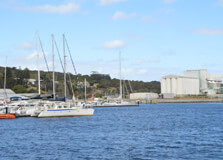
Princess Royal Harbour is a picturesque and historically significant inlet located in the city of Albany, Western Australia. Known for its tranquil waters and stunning natural beauty, the harbour is a popular destination for tourists and locals alike. Its strategic location has also played an important role in Albany’s history, with the harbour once serving as a vital port for shipping. Today, it’s not only a place to admire the beauty of nature but also a spot to learn about the rich maritime heritage of the area. Whether you're interested in relaxing by the water, taking a cruise, or exploring Albany’s history, Princess Royal Harbour offers something for everyone. How to Reach Princess Royal Harbour, Albany Getting to Princess Royal Harbour is easy, as it is located just a short distance from the city center of Albany. The harbour is within walking distance from the town, and visitors can easily reach it by car, taxi, or even bike. If you're driving, simply head to the harbor area via Albany's main roads, including York Street. For those relying on public transport, buses run regularly between the city center and key spots near the harbour, making it convenient to access from various parts of the town. If you're arriving from outside of Albany, the closest airport is Albany Airport (ALH), which is around 10 minutes away by car. Weather and Best Time to Visit The weather in Albany is temperate, making it an ideal location for year-round visits. Summers are mild to warm, with temperatures ranging between 15°C and 25°C. Winters are cooler, with temperatures averaging between 8°C and 18°C. The best time to visit Princess Royal Harbour is during the warmer months of spring and summer when the weather is perfect for outdoor activities. However, winter visits also offer a serene and quiet experience, especially for those interested in whale watching or enjoying the cooler, misty mornings. It's advisable to check the weather forecast before your trip, as the coastal weather can sometimes change rapidly. Timing and Entry Details Princess Royal Harbour is open to the public year-round, and there is no entry fee to access the harbour itself. The harbour area is accessible at all hours, though it is best to visit during the day to make the most of the natural light and to fully enjoy the views. Many tourists prefer visiting in the morning or afternoon to catch the best lighting for photography and to experience the peacefulness of the water. If you’re planning to take a harbour cruise or engage in any specific activities, it's recommended to check schedules in advance, as tours may have set departure times. Most local businesses near the harbour operate between 8:00 AM and 5:00 PM, so plan accordingly for services like cafes and shops. Why Princess Royal Harbour is Famous for Albany Princess Royal Harbour is famous for its breathtaking beauty, historical significance, and natural wildlife. As one of the most picturesque harbours in Western Australia, it is often visited for its peaceful waters and stunning surrounding landscapes. The harbour also holds historical importance, having been used for centuries as a shipping port and a place for maritime trade. It was the site where early European settlers arrived in the 1800s, marking Albany as one of the first points of European contact with Australia. The harbour is also a popular spot for local and international tourists due to its serene atmosphere, ideal for various outdoor activities like boating, fishing, and sightseeing. Visitors to Albany often make Princess Royal Harbour a must-see destination due to its scenic views and the opportunity to engage with the area's rich maritime history. History and Architecture of Princess Royal Harbour Princess Royal Harbour has a rich history dating back to the early days of European exploration. It was first mapped by Captain George Vancouver in 1791, during his expedition along the south coast of Australia. The harbour became a critical site for maritime activity and trade, especially during the early settlement period in Albany. It was named after Princess Royal, the eldest daughter of King George IV. The harbour's sheltered waters made it an ideal location for a port, and it played a significant role in the early economy of the region. Today, remnants of Albany's maritime history can still be found around the harbour area, including old wharves and buildings that reflect the town’s naval heritage. Things to Do at Princess Royal Harbour There are plenty of activities to enjoy at Princess Royal Harbour, making it an exciting destination for nature lovers, history buffs, and families alike. Here are some of the top things to do when visiting: Harbour Cruises: One of the best ways to experience the beauty of Princess Royal Harbour is by taking a guided cruise. Several operators offer boat tours that take you around the harbour, offering spectacular views of the water, surrounding cliffs, and Albany’s coastline. Fishing and Boating: Princess Royal Harbour is a popular spot for recreational boating and fishing. You can rent a boat or bring your own to enjoy a day on the water. It’s a fantastic place for both experienced anglers and beginners to try their luck. Photography: The calm waters and stunning views of the harbour make it a perfect location for photographers. Whether you’re capturing the sunrise over the water or taking photos of the harbour's natural beauty, there are plenty of opportunities for stunning shots. Walking and Exploring: The area surrounding the harbour is perfect for walking and exploration. Visitors can enjoy leisurely walks along the coastline, where you’ll have panoramic views of the harbour, the ocean, and the city. There are also historical landmarks nearby, such as the Albany Heritage Park and the Albany Whaling Station, that offer insight into the region’s past. Whale Watching: Princess Royal Harbour is a prime spot for whale watching, particularly during the migration season. From June to October, humpback and southern right whales migrate along the coast, and you may be able to see these magnificent creatures from the shore or on a boat tour. Facts About Princess Royal Harbour Here are a few interesting facts about Princess Royal Harbour: Princess Royal Harbour is one of the largest natural harbours in Australia, stretching over 10 kilometers in length. The harbour played a pivotal role in the establishment of Albany as a major port in the 19th century, serving as a vital link for trade and transportation. The harbour is home to a rich variety of marine life, including dolphins, seals, and various seabirds. The harbour is part of the Albany Heritage Park, which preserves the area’s cultural and historical significance. Princess Royal Harbour offers one of the best vantage points for seeing the surrounding landscape, including the famous Mount Clarence and the surrounding cliffs. Tips for Visiting Princess Royal Harbour Here are some helpful tips to ensure you have a great experience at Princess Royal Harbour: Wear comfortable clothing: If you plan on walking or hiking around the harbour, be sure to wear comfortable shoes and clothing suited to outdoor activities. Check whale watching schedules: If you’re visiting during whale migration season, check local whale watching tour schedules to maximize your chances of seeing these magnificent animals. Bring sunscreen: The sun can be strong, especially during summer months, so be sure to bring sunscreen, a hat, and sunglasses for protection. Plan ahead for tours: If you’re interested in taking a cruise or guided tour, it’s best to book in advance to ensure availability during your visit. Respect the environment: Remember to respect local wildlife and follow any guidelines provided to preserve the natural beauty of Princess Royal Harbour. Conclusion Princess Royal Harbour is a spectacular natural attraction in Albany that offers a blend of history, natural beauty, and outdoor activities. Whether you're interested in learning about the area's maritime history, exploring the stunning views, or simply enjoying a peaceful day by the water, there’s something for everyone to enjoy. With its calm waters, scenic surroundings, and range of things to do, Princess Royal Harbour is one of the must-visit destinations in Albany, offering a truly unforgettable experience for all types of travelers.
Explore MoreNew Zealand - Australia 16 Nights 17 Days Tour
17 Days/ 16 Night
Sydney - Melbourne - Auckland - Christchurch - Rotorua - Queenstown - Gold Coast
Australian Getaway With Tangalooma Island 10 Nights - 11 Days Tour
11 Days/ 10 Night
Sydney - Melbourne - Gold Coast
Majestic Australia 11 Nights - 12 Days Tour
12 Days/ 11 Night
Sydney - Cairns - Melbourne - Gold Coast
Magical Queensland 8 Nights - 9 Days Tour
9 Days/ 8 Night
Cairns - Brisbane - Gold Coast

Middleton Beach is one of the most popular and picturesque coastal spots in Albany, Western Australia. Known for its pristine golden sands, clear blue waters, and stunning views, it is an ideal location for visitors seeking relaxation, outdoor activities, and natural beauty. Whether you are looking to swim, picnic, or explore the surrounding areas, Middleton Beach offers something for everyone. The beach is perfect for families, solo travelers, and couples who want to enjoy the tranquil yet vibrant atmosphere that this beautiful destination offers. How to Reach Middleton Beach, Albany Middleton Beach is conveniently located just 5 minutes by car from the center of Albany, Western Australia, making it an easy destination to access. From the Albany city center, head east along York Street and continue on to Marine Drive, where the beach will be on your left. The drive to Middleton Beach is straightforward, and ample parking is available near the beach, including free parking at designated areas. Visitors can also take public transport, with several bus services running between Albany and Middleton Beach. For those arriving by air, Albany Airport (ALH) is approximately 15 minutes by car from the beach. Weather and Best Time to Visit Middleton Beach enjoys a temperate maritime climate, which means mild, pleasant weather throughout the year. The best time to visit is during the warmer months from December to March, when the average temperature ranges from 18°C to 25°C. During these months, the weather is ideal for beach activities like swimming, sunbathing, and picnicking. However, Middleton Beach is a great destination to visit year-round. Winter (from June to August) is cooler, with temperatures averaging between 8°C and 15°C, making it a perfect time for those who enjoy coastal walks, photography, and fewer crowds. Why Middleton Beach is Famous Middleton Beach is famous for its natural beauty, peaceful atmosphere, and range of activities. The beach offers a safe, sheltered environment for swimming and picnicking, making it a favorite among locals and tourists alike. It’s also renowned for its close proximity to Albany’s iconic landmarks, such as the Albany Wind Farm, and is a perfect spot to enjoy stunning views of King George Sound. Middleton Beach is known for its clean, inviting waters and golden sands, making it ideal for both relaxation and outdoor recreation. Its laid-back vibe, complemented by the surrounding coastal scenery, also makes it a popular location for photography enthusiasts. Entry and Visit Details about Middleton Beach Middleton Beach is open to the public year-round, and there is no entry fee to access the beach itself. However, if you are planning to park in one of the designated areas, be sure to check parking regulations as some areas may have time restrictions or require a permit. The beach is easily accessible, and visitors can enjoy various facilities, including public restrooms, picnic tables, and a kiosk for snacks and drinks. Visitors can also find shaded areas where they can relax and enjoy the beach while staying out of the sun. For those wanting to make a day of it, there are also nearby restaurants and cafes offering delicious local cuisine. Things to Do at Middleton Beach Middleton Beach offers a variety of activities for all ages and interests. Whether you enjoy water sports, exploring the area, or simply relaxing by the sea, there is something for everyone at this popular location. Some of the best things to do at Middleton Beach include: Swimming: The clear, calm waters of Middleton Beach are perfect for swimming. The beach is protected by a reef, making it a safe spot for swimmers of all levels, including families with children. Walking and Jogging: The beach has a scenic walking trail that runs along the coastline. It is perfect for those who want to go for a walk, jog, or enjoy a leisurely stroll with panoramic ocean views. Picnicking: There are numerous picnic areas with BBQ facilities along the beach, where visitors can relax and enjoy a meal with a stunning view of the ocean. It’s a great way to spend a sunny afternoon. Photography: Middleton Beach offers breathtaking views, perfect for photography. The soft light in the early morning and late afternoon, combined with the stunning natural beauty, makes this beach ideal for capturing memorable photos. Kayaking and Paddleboarding: For those who love water sports, Middleton Beach offers ideal conditions for kayaking and paddleboarding. Rentals are available for visitors who want to explore the waters from a different perspective. Wildlife Watching: Middleton Beach is a great location to spot local wildlife. In addition to various bird species, visitors may also see dolphins and sea lions playing in the waters, especially in the early morning or late afternoon. Beach Volleyball: The beach area is large enough to set up a casual game of beach volleyball. It’s a fun way to enjoy the sun and sand with friends or family. History and Architecture of Middleton Beach Middleton Beach has a rich history that dates back to the early European settlement of Albany. It was originally known as "Middleton Bay" and was used by whalers and explorers during the 19th century. Over time, it has evolved into a popular recreational area and an iconic spot in Albany. The area surrounding the beach has been developed with tourism in mind, and there are several modern amenities and facilities available for visitors, including cafes, restaurants, and accommodations. While Middleton Beach itself is not known for historical buildings or structures, it does offer a mix of natural beauty and modern developments that make it a charming place to visit. Facts About Middleton Beach Here are some interesting facts about Middleton Beach: The beach is named after Captain John Middleton, an early explorer who mapped the area in the early 19th century. Middleton Beach is one of Albany’s most visited beaches, attracting both locals and tourists throughout the year. In addition to its recreational activities, Middleton Beach is an important area for environmental conservation, with local efforts focused on preserving its natural beauty. The beach is part of the larger King George Sound area, which is historically significant for its use as a safe harbor by early European explorers. The beach is a favorite location for sunset viewing, with the stunning colors over the water creating a breathtaking scene each evening. Tips for Visiting Middleton Beach To make the most of your visit to Middleton Beach, here are some helpful tips: Arrive Early: To avoid the crowds, especially during peak tourist seasons, try to arrive early in the morning or later in the afternoon for a quieter experience. Bring Sunscreen: The Australian sun can be harsh, so make sure to bring sunscreen and a hat to protect yourself from the sun while enjoying the beach. Stay Hydrated: Bring plenty of water, especially if you plan on spending the day at the beach or enjoying outdoor activities. Respect the Environment: Middleton Beach is a protected area, so be sure to follow Leave No Trace principles, clean up after yourself, and respect the wildlife. Check the Tide: If you plan to swim or engage in water sports, make sure to check the tide times, as this can affect the water conditions at the beach. Conclusion Middleton Beach is a gem in Albany, offering visitors the chance to experience the best of Western Australia’s coastal beauty. Whether you’re looking to relax on the golden sands, enjoy water sports, or simply take in the incredible scenery, Middleton Beach is a destination that will leave you with lasting memories. With its tranquil atmosphere, convenient location, and range of activities, Middleton Beach is a must-visit location for anyone traveling to Albany.
Explore More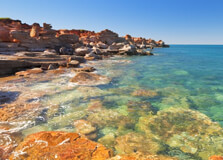
Gantheaume Point is one of the most fascinating natural attractions in Broome, Western Australia. It is a striking coastal landmark known for its red sandstone cliffs, dramatic ocean views, and historic dinosaur footprints embedded in the rocks. Located just a short drive from Cable Beach, this stunning location combines natural beauty, geology, and ancient history. Gantheaume Point offers a peaceful escape from the town center and is perfect for sightseeing, photography, and learning about Broome’s prehistoric past. How to Reach Gantheaume Point, Broome Gantheaume Point is approximately 6 kilometers from Broome's town center and easily accessible by car or bicycle. You can drive along Gantheaume Point Road, which is well signposted. The drive takes around 10 to 15 minutes from the town or Cable Beach. Taxis, bikes, and local tour operators also provide access to the area. There’s a small parking area at the end of the road, and the site is free to visit. It’s recommended to go during low tide if you want to see the dinosaur footprints. Weather Gantheaume Point, like the rest of Broome, has a tropical climate with two main seasons: the dry season (April to October) and the wet season (November to March). During the dry season, you can expect clear skies, low humidity, and pleasant temperatures between 17°C and 30°C. The wet season brings hotter weather, higher humidity, and the possibility of thunderstorms or cyclones. The best time to visit is during the dry season for ideal conditions and easy access to the rock formations. Timing Gantheaume Point is open to the public 24 hours a day, and there are no restricted visiting hours. However, the best time to visit is during daylight hours, especially around sunrise or sunset when the lighting enhances the red cliffs and ocean views. If you want to see the dinosaur footprints, you must visit during low tide, as they are only visible when the tide is out. It’s advisable to check the local tide charts before planning your visit. Why Famous for Broome? Gantheaume Point is one of the key attractions that make Broome famous. The area is known for its ancient dinosaur footprints that are over 130 million years old, making it a site of international geological significance. The contrast between the deep red cliffs and the blue waters of the Indian Ocean creates a dramatic and unforgettable landscape. Gantheaume Point is also part of Broome's unique blend of history, natural wonder, and Indigenous culture, all of which draw visitors to the region. Entry and Visit Details about Gantheaume Point, Broome Entry to Gantheaume Point is free of charge, and there are no tickets or passes required. The area is unstaffed and has basic facilities. There is a small car park and some information signs, but there are no cafes or shops on-site, so it’s a good idea to bring water and sun protection. The path down to the rocks can be uneven and slippery, especially near the tide pools, so sturdy shoes are recommended. Access to the dinosaur footprints is only possible at very low tide, so checking the tide times is essential. History and Architecture Gantheaume Point is rich in natural history. The site is famous for its dinosaur footprints preserved in the reef rock platform, which date back to the Early Cretaceous period around 130 million years ago. These footprints were made by different types of dinosaurs, including carnivorous theropods and long-necked sauropods. A plaster cast of some of the footprints has been placed at the top of the cliffs for easier viewing when tides are high. The architecture at Gantheaume Point is not man-made but geological—red sandstone formations shaped by centuries of wind and ocean erosion. Things to Do Visitors to Gantheaume Point can enjoy a variety of activities: Dinosaur Footprints: Walk down to the reef during low tide to see the preserved dinosaur tracks in the rocks. Photography: The contrast of red rocks against blue ocean creates perfect photo opportunities, especially at sunrise or sunset. Whale Watching: From July to September, you might spot migrating humpback whales offshore. Scenic Walks: Explore the rocky coastline, tidal pools, and cliffs for a relaxing nature experience. Learn Geology: This is a great spot for those interested in Earth's history and rock formations. Visit Anastasia’s Pool: A small natural rock pool carved out by a lighthouse keeper for his ill wife, adding a romantic and historic touch to the site. Facts and Tips about Gantheaume Point, Broome Here are some helpful tips and interesting facts for visiting Gantheaume Point: Best Time: Visit during low tide to see the dinosaur footprints. Bring a tide chart or check online before heading there. Footwear: Wear closed-toe shoes or hiking sandals to safely walk over rocks and uneven surfaces. Sun Safety: Bring sunscreen, sunglasses, a hat, and water, as there is little to no shade at the site. Photography: Ideal lighting occurs in the early morning or evening. Drones may be used in accordance with local rules. Accessibility: The area is not wheelchair-friendly, and the walk to the footprints can be challenging for those with mobility issues. Wildlife: Keep an eye out for local bird species and marine life. During whale season, bring binoculars for better viewing. Gantheaume Point is a remarkable destination that combines natural beauty, prehistoric wonder, and peaceful atmosphere. It offers a unique opportunity to step back in time and witness ancient history while enjoying stunning coastal scenery. Whether you're a nature lover, history enthusiast, or just someone looking to unwind, Gantheaume Point is a place you should not miss while in Broome.
Explore More
The Broome Historical Museum is a treasure trove of information and artifacts that tell the fascinating story of Broome’s past. Located in the northwestern town of Broome, Western Australia, this museum provides deep insight into the region's cultural, economic, and social heritage. From its early pearling days and World War II history to the multicultural influences that shaped the town, the museum offers a rich and educational experience for all ages. The museum is set within two heritage-listed buildings—one a former Customs House and the other a courthouse. With carefully curated exhibitions, photographs, audio recordings, and original artifacts, the museum captures the spirit of Broome and its unique place in Australian history. How to Reach Broome Historical Museum, Broome The Broome Historical Museum is located at 67 Robinson Street, in the heart of Broome. It’s easily accessible by car, bike, or foot, especially if you are staying in Broome’s town center. From Broome International Airport, it’s only a 5-10 minute drive or taxi ride. Public buses and tour services around town also stop near the museum, making it convenient for tourists. There is free parking available outside the museum, and bicycle racks are provided for visitors cycling from nearby areas. Weather Broome experiences a tropical climate with two distinct seasons: the dry season (May to October) and the wet season (November to April). The dry season is the most popular time to visit, with pleasant temperatures ranging from 20°C to 30°C and minimal rainfall. This is when the museum sees the highest number of visitors. During the wet season, the area experiences higher humidity, heavy rainfall, and occasional storms. While the museum may still be open, visitor numbers are lower, and it's best to check local weather forecasts and opening hours before visiting during this time. Timing The Broome Historical Museum is generally open from 10:00 AM to 1:00 PM daily during the peak tourist season (April to October). Hours may be shorter or vary during the off-season, so it is advisable to check their official website or contact the museum before planning your visit. Most visitors spend around 1 to 2 hours exploring the museum, but history enthusiasts might enjoy spending longer. Guided tours are sometimes offered by volunteers and provide deeper context about Broome's fascinating past. Why Famous for Broome? The Broome Historical Museum plays a key role in preserving the town’s rich and multicultural heritage. Broome has a long and complex history shaped by Aboriginal culture, the pearling industry, Japanese immigrants, and European settlers. The museum documents these influences through detailed exhibits and personal stories. It is especially famous for its displays on the pearling era, wartime bombing of Broome during World War II, and its Aboriginal heritage. For many, the museum offers an emotional and educational connection to the town's diverse past, making it a must-visit destination in Broome. Entry and Visit Details about Broome Historical Museum, Broome The entry fee to the museum is modest and helps support the ongoing preservation of Broome’s history. Adults generally pay around AUD $12, while concessions and children are offered discounted rates. Family tickets are also available. The museum is wheelchair accessible and offers brochures and displays in several languages. There is a small gift shop with local books, souvenirs, and handmade crafts available for purchase. Donations are welcome, and visitors are encouraged to support the museum’s upkeep and community programs. History and Architecture The Broome Historical Museum is housed in two significant heritage buildings. The main building was originally the town’s Customs House and later served as the Broome Courthouse. These colonial-era buildings were constructed in the late 19th century and reflect simple but sturdy architecture suited to the region’s climate. The museum was established in the 1970s by local volunteers and the Broome Historical Society. Since then, it has grown into one of the most respected regional museums in Western Australia. The architecture and old photographs in the exhibits give visitors a strong sense of what life was like in Broome over the past century. Things to Do The Broome Historical Museum offers a variety of engaging activities and displays: Explore Pearling History: Learn about Broome’s pearling industry and view actual pearl diving gear, boats, and tools used in the early 20th century. Aboriginal Culture Displays: Understand the rich cultural heritage of the Yawuru people, the traditional custodians of the land. World War II Exhibit: See exhibits related to the bombing of Broome in 1942, including survivor accounts and photographs. Japanese Cemetery Stories: Discover the stories behind Japanese divers who contributed to Broome’s economy and community. Audio-Visual Presentations: Watch short documentaries and interviews with long-time residents and historians. Photography and Memorabilia: Enjoy thousands of archived images and personal items donated by Broome families. Facts and Tips about Broome Historical Museum, Broome Here are some interesting facts and helpful tips for your visit: Volunteer-Run: The museum is run mainly by volunteers from the Broome Historical Society, making it a true community effort. Historical Cemetery Nearby: The Japanese Cemetery is located nearby and can be visited in the same trip. Photography Allowed: Visitors can take non-flash photos inside most areas of the museum. Quiet Time: If you prefer a quieter visit, come early in the morning when it’s less crowded. Great for Families: Children can learn about Broome through fun exhibits, including interactive displays and storytelling boards. Educational Resource: The museum is an excellent learning spot for school groups and researchers. The Broome Historical Museum is more than just a building—it’s a living record of a town shaped by adventure, struggle, and multicultural cooperation. Whether you are a history lover or a casual traveler, the museum offers a deep, meaningful glimpse into the people and events that made Broome the unique place it is today.
Explore More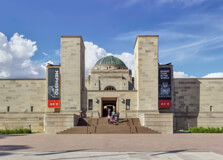
The Australian War Memorial is one of Australia's most significant landmarks, honoring the sacrifice of the nation's military personnel. Located in Canberra, it serves as a museum, shrine, and archive, offering a comprehensive look into Australia's wartime history. How to Reach Australian War Memorial, Canberra By Car: Ample parking is available at the site. By Bus: Public buses frequently service the memorial from central Canberra. By Bicycle/Walking: Located near the city center, accessible via walking and cycling paths. Weather in Canberra Canberra experiences four seasons: Summer (December-February): Warm, 12-30°C (54-86°F). Autumn (March-May): Mild, 7-20°C (45-68°F). Winter (June-August): Cold, 0-12°C (32-54°F). Spring (September-November): Pleasant, 5-22°C (41-72°F). Timings of Australian War Memorial Open daily from 10 AM to 5 PM. Closed on Christmas Day. Why is Australian War Memorial Famous? The memorial is famous for its extensive exhibits on Australian military history, the Hall of Memory, and the Last Post Ceremony, held daily at sunset. Entry and Visit Details Entry: Free, but donations are welcome. Guided Tours: Available at no cost, covering different aspects of the memorial. History and Architecture Established in 1941, the memorial combines Byzantine and Art Deco architectural styles. Its Hall of Memory contains the Tomb of the Unknown Australian Soldier. Things to Do Explore the Museum: View extensive collections of military artifacts and exhibitions. Attend the Last Post Ceremony: A moving tribute to fallen soldiers. Walk the Sculpture Garden: Featuring war-related sculptures and tributes. Facts about Australian War Memorial Designed by architect Emil Sodersten. Home to the Roll of Honour, listing over 102,000 fallen Australian soldiers. One of the most visited landmarks in Australia. Tips for Visiting Arrive early to explore at a comfortable pace. Book a guided tour to gain in-depth insights. Wear comfortable shoes for walking through exhibitions.
Explore More
The National Museum of Australia is a premier cultural institution located in Canberra. It showcases the rich history, heritage, and diverse cultures of Australia, covering Indigenous histories, European settlement, and contemporary society. How to Reach National Museum of Australia, Canberra By Car: Free and paid parking available on-site. By Bus: Regular public transport services connect the museum with central Canberra. By Bicycle/Walking: Located near Lake Burley Griffin, it is accessible via scenic walking and cycling paths. Weather in Canberra Canberra has four distinct seasons: Summer (December-February): Warm, 12-30°C (54-86°F). Autumn (March-May): Mild, 7-20°C (45-68°F). Winter (June-August): Cold, 0-12°C (32-54°F). Spring (September-November): Pleasant, 5-22°C (41-72°F). Timings of National Museum of Australia Open daily from 9 AM to 5 PM. Closed on Christmas Day. Why is National Museum of Australia Famous? The museum is known for its engaging exhibitions on Australian history, including Indigenous cultures, settlement history, and modern societal changes. It also features unique interactive displays and temporary exhibitions. Entry and Visit Details Entry: Free general admission, but some special exhibitions may have fees. Guided Tours: Available for a fee, providing in-depth insights into exhibits. History and Architecture Opened in 2001, the museum's architecture is inspired by a puzzle, symbolizing Australia's diverse and interwoven history. The building's unique design, with bright colors and curved shapes, makes it a striking landmark in Canberra. Things to Do Explore Permanent Exhibitions: Covering Indigenous heritage, environmental history, and contemporary Australia. Visit the Garden of Australian Dreams: An interactive outdoor exhibit reflecting Australia's landscapes and history. Enjoy Hands-on Activities: Interactive displays and workshops for families and children. Facts about National Museum of Australia Designed by architect Howard Raggatt. Home to the famous "Circa" rotating theatre. Houses the world’s largest collection of Aboriginal bark paintings. Tips for Visiting Plan at least 2-3 hours to explore exhibits thoroughly. Check the museum’s website for current temporary exhibitions. Visit the café for scenic views of Lake Burley Griffin.
Explore More
Parliament House Canberra is the meeting place of the Parliament of Australia and a symbol of the nation’s democracy. Located in the capital city, Canberra, it is an architectural masterpiece with modern design elements and extensive landscaping. How to Reach Parliament House Canberra By Car: Easily accessible with on-site parking available for visitors. By Bus: Multiple public transport options connect to Parliament House. By Bicycle/Walking: Scenic paths lead to the site, making it a pleasant walk from central Canberra. Weather in Canberra Canberra experiences varied seasons: Summer (December-February): Warm, 12-30°C (54-86°F). Autumn (March-May): Mild, 7-20°C (45-68°F). Winter (June-August): Cold, 0-12°C (32-54°F). Spring (September-November): Pleasant, 5-22°C (41-72°F). Timings of Parliament House Canberra Open to visitors daily from 9 AM to 5 PM, with guided tours available. Closed on Christmas Day. Why is Parliament House Canberra Famous? It is the heart of Australian democracy and an iconic architectural structure known for its unique design, historic significance, and public accessibility. Entry and Visit Details Entry Fees: Free general entry, with special guided tours available at an additional cost. Public Access: Visitors can explore the Great Hall, Senate, and House of Representatives chambers. History and Architecture Opened in 1988, Parliament House was designed by architect Romaldo Giurgola. The structure features a grass-covered roof, allowing visitors to walk above the building and enjoy panoramic views of Canberra. Things to Do Attend Parliamentary Sessions: Watch live debates and discussions. Explore the Art Collection: View significant Australian artworks and historic displays. Walk on the Roof: Experience the stunning view from the rooftop. Facts about Parliament House Canberra The building covers 32 hectares. It houses over 4,700 rooms. The flagpole above the building stands 81 meters tall. Tips for Visiting Arrive early to join a guided tour. Security checks are mandatory, so carry minimal items. Wear comfortable shoes for exploring the vast interiors and grounds.
Explore More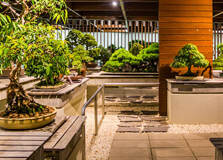
Bonsai at National Arboretum in Canberra is a remarkable collection showcasing the ancient art of bonsai and penjing. It features miniature trees that have been cultivated and shaped for decades, offering visitors a unique and tranquil experience. How to Reach Bonsai at National Arboretum, Canberra By Car: Easily accessible with parking available on-site. By Bus: Several public transport options stop near the arboretum. By Bicycle/Walking: The arboretum is connected to scenic trails for walkers and cyclists. Weather in Canberra Canberra experiences distinct seasonal changes: Summer (December-February): Warm and dry, 12-30°C (54-86°F). Autumn (March-May): Mild with beautiful foliage, 7-20°C (45-68°F). Winter (June-August): Cold with occasional frost, 0-12°C (32-54°F). Spring (September-November): Blooming flowers and greenery, 5-22°C (41-72°F). Timings of Bonsai at National Arboretum, Canberra Open daily from 9 AM to 4 PM. Closed on Christmas Day. Why is Bonsai at National Arboretum, Canberra Famous? This exhibition is renowned for its stunning collection of miniature trees, some over 100 years old. It showcases the artistry and cultural significance of bonsai and penjing. Entry and Visit Details Entry Fees: Free entry, with guided tours available at a cost. Public Access: Visitors can explore the bonsai pavilion, enjoy peaceful surroundings, and attend workshops. History and Architecture The bonsai collection was established to celebrate the art form and educate visitors about the techniques used to maintain these miniature trees. The exhibit space is thoughtfully designed to highlight each bonsai's unique character. Things to Do Guided Tours: Learn about bonsai care and history from experts. Photography: Capture the intricate beauty of the miniature trees. Workshops: Participate in bonsai cultivation and maintenance sessions. Relaxation: Enjoy a peaceful walk through the exhibition. Facts about Bonsai at National Arboretum, Canberra Houses over 100 bonsai and penjing specimens. Some bonsai in the collection are over a century old. Features trees donated by bonsai masters from around the world. Tips for Visiting Visit in the morning for the best lighting for photos. Respect the trees by not touching them. Check for seasonal workshops and exhibitions. Combine your visit with other attractions at the arboretum.
Explore More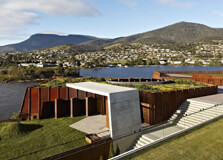
MONA, short for the Museum of Old and New Art, is one of the most popular and unique attractions in Hobart, Tasmania. Opened in 2011 by Tasmanian millionaire David Walsh, MONA has become famous around the world for its bold, unconventional, and sometimes controversial approach to art. It is the largest privately-funded museum in the Southern Hemisphere and is located on the banks of the River Derwent, just outside of Hobart. How to Reach MONA, Hobart Getting to MONA is an experience in itself. The most popular and scenic way to reach MONA is by ferry from Hobart’s Brooke Street Pier. The ferry ride takes about 25 minutes and offers great views of the city and river. MONA’s private ferry, the MONA ROMA, is stylish and themed, featuring sheep-shaped seats and a funky vibe. Alternatively, you can drive to MONA. It is about 11 kilometers from the city center and takes roughly 20 minutes by car or taxi. Public buses also run from Hobart to Berriedale, where the museum is located. There's also ample parking if you decide to drive yourself. Weather in Hobart Hobart has a mild oceanic climate. Summers (December to February) are generally warm and pleasant with temperatures ranging from 12°C to 25°C. Winters (June to August) are cool and sometimes rainy, with average temperatures ranging from 4°C to 12°C. Spring and autumn are mild and beautiful seasons to visit MONA, though it’s open year-round. It’s a good idea to bring a jacket, even in summer, as the weather in Hobart can change quickly. Rain showers are common, so packing a small umbrella or raincoat is recommended. Timing of MONA MONA is open from Friday to Monday, from 10:00 AM to 5:00 PM. It is closed on Tuesdays and Wednesdays, and sometimes on special holidays or for maintenance. It's always a good idea to check the official MONA website before planning your visit to confirm current opening hours and any changes. Why is MONA Famous in Hobart? MONA has gained worldwide recognition for its daring and experimental exhibitions. It challenges traditional ideas of what a museum should be and presents art in a bold and often provocative way. Some of its pieces explore themes of sex, death, and human nature, which has sparked both praise and controversy. The museum has significantly boosted tourism in Tasmania and has become a cultural landmark. It’s not just a museum; it’s a complete experience involving art, architecture, wine, fine dining, and performance. Entry and Visit Details about MONA, Hobart Entry to MONA is free for Tasmanian residents. For other visitors, ticket prices may vary but generally start from around AUD $35 for adults. Discounts are available for seniors, students, and children. Tickets can be purchased online or at the entrance, but advance booking is recommended, especially during peak seasons. Upon entry, visitors receive a digital guide called “The O,” which provides information about each exhibit through GPS location tracking. Instead of traditional wall labels, visitors use The O to explore the stories behind the artworks at their own pace. History and Architecture MONA was founded by David Walsh, a Tasmanian gambler and art collector who made his fortune through a gambling system based on mathematical algorithms. His vision was to create a space where people could engage with art in a personal and emotional way. The museum is built into a cliff on the Berriedale Peninsula. From the outside, it appears modest, but the interior is a dramatic underground labyrinth carved into sandstone. The building itself is a work of art, with spiral staircases, dark tunnels, and open spaces that make the journey through MONA feel like an adventure. Things to Do at MONA - Explore diverse exhibitions that feature ancient artifacts, contemporary installations, and digital media. - Enjoy a wine tasting at Moorilla Winery, located on-site. - Dine at the gourmet The Source Restaurant, known for its local and seasonal cuisine. - Relax at the Faro Bar + Restaurant with beautiful river views. - Take a stroll through the MONA grounds, which include outdoor sculptures, gardens, and the winery. - Attend live music and cultural events, especially during MONA’s festivals such as Dark Mofo and MOFO. - Visit the gift shop for unique and quirky souvenirs related to art and Tasmania. Facts and Tips about MONA, Hobart - MONA stands for “Museum of Old and New Art.” - It houses over 1,900 artworks from around the world. - The building cost over AUD $75 million to build. - It’s recommended for adults and older teens due to some graphic or mature content. - The ferry ride offers VIP seating (known as the “Posh Pit”) with free drinks and snacks. - Wear comfortable shoes; the museum involves a lot of walking and stairs. - Photography is allowed, but flash is prohibited. - Free Wi-Fi is available on-site. - Plan to spend at least 3–4 hours, or a full day, if you want to enjoy all the museum and its facilities.
Explore More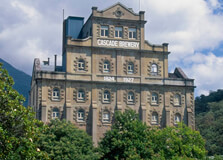
Cascade Brewery, located in Hobart, Tasmania, is Australia's oldest operating brewery. Established in 1824, it is nestled at the foot of the majestic Mount Wellington and surrounded by lush gardens and scenic landscapes. The brewery is a significant part of Tasmania's cultural heritage and continues to attract tourists from all over the world. It combines traditional brewing techniques with modern facilities, making it not just a place for beer lovers but also a historical and architectural gem. How to Reach Cascade Brewery, Hobart Cascade Brewery is situated about 4 kilometers from the Hobart city center. You can easily reach the brewery by car, taxi, or public transport. The drive from the city center takes approximately 10 minutes. Public buses also operate regularly to the South Hobart area, with bus stops located within walking distance of the brewery. If you're up for a more scenic approach, cycling or walking from the city offers a pleasant experience with picturesque views. Weather Hobart has a temperate maritime climate, which means mild summers and cool winters. The weather can be quite unpredictable, so it's a good idea to dress in layers. Summer (December to February) is the best time to visit, with temperatures ranging between 17°C to 23°C. Winter months (June to August) can be quite chilly, with temperatures dropping to around 4°C to 12°C. Spring and autumn are also lovely times to visit, offering crisp air and fewer crowds. Timing Cascade Brewery is generally open to visitors every day of the week. The Cascade Brewery Bar is open from 11:00 AM to 5:00 PM, while guided tours usually run from 11:00 AM to 3:00 PM. It’s advisable to check the official website or contact them in advance as hours may change due to events, holidays, or weather conditions. Why Cascade Brewery is Famous in Hobart Cascade Brewery is famous for being the oldest continually operating brewery in Australia. Beyond its rich brewing history, the site is admired for its beautiful heritage-listed building and stunning gardens. It is a symbol of Tasmanian pride and a popular destination for those interested in craft beer, history, and architecture. The brewery has also played a major role in the local economy and culture, making it a must-visit landmark in Hobart. Entry and Visit Details Visitors can enjoy a variety of experiences at Cascade Brewery. There is no entry fee to access the gardens or the Cascade Brewery Bar. However, guided tours are available at a cost. The standard brewery tour usually costs around AUD $30–$35 per person and includes a guided walk through the brewery, a look at the brewing process, and a tasting session of different beers. It's recommended to book tours in advance, especially during peak tourist seasons. Participants in brewery tours must be 16 years or older, and tastings are available only for those above the legal drinking age. History and Architecture Cascade Brewery was founded in 1824 by Peter Degraves, who played a major role in Hobart's early development. The original building still stands and has become one of Hobart’s most recognizable landmarks. The main structure is a grand example of colonial industrial architecture, constructed using locally quarried stone and featuring a tall facade with arched windows and detailed masonry. Over the years, the brewery has undergone modernization, but it has carefully preserved the original architectural charm. The historic building, set against the backdrop of Mount Wellington, is often described as one of the most picturesque breweries in the world. Things to Do at Cascade Brewery There is plenty to see and do at Cascade Brewery. Here are some popular activities: Guided Brewery Tours: Learn about the beer-making process and explore the facilities. Tasting Sessions: Enjoy a variety of Cascade beers in the Brewery Bar. Garden Walks: Stroll through the beautifully maintained gardens and enjoy the scenery. Dining: Relax at the Cascade Brewery Bar which offers a range of meals and snacks, often using local Tasmanian produce. Photography: The building and surroundings are a photographer’s delight, especially with Mount Wellington in the backdrop. Facts and Tips about Cascade Brewery, Hobart Here are some interesting facts and helpful tips for your visit: The brewery has been operational since 1832 (the company was established in 1824). It is one of the few breweries in Australia to still brew its beer on-site. The surrounding gardens are home to native Tasmanian plants and wildlife. Book your tour early during the summer season to avoid disappointment. Wear comfortable shoes for walking during the tour. The brewery tour includes stairs and may not be suitable for those with mobility issues. Bring a camera – the historic architecture and scenic views are worth capturing. Cascade Brewery is a must-visit destination in Hobart for those interested in history, architecture, and, of course, great beer. Its tranquil surroundings and historic charm make it an ideal spot for a relaxing afternoon or an informative guided tour. Whether you're a history buff, a beer enthusiast, or simply exploring Hobart, Cascade Brewery offers something unique and memorable.
Explore More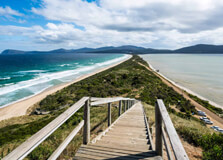
Bruny Island is one of Tasmania’s most beautiful natural attractions, located just off the southeastern coast of Hobart. Known for its stunning landscapes, wildlife, gourmet food, and peaceful atmosphere, Bruny Island offers a perfect escape for nature lovers and adventurers. The island is actually made up of two parts – North Bruny and South Bruny – connected by a narrow strip of land called "The Neck." It is a must-visit destination for those exploring Tasmania and looking for an experience that combines nature, history, and local culture. How to Reach Bruny Island, Hobart Bruny Island is easily accessible from Hobart. The journey involves a scenic drive followed by a short ferry ride. First, drive from Hobart to Kettering, which takes about 30–40 minutes. From Kettering, take the Bruny Island Ferry operated by SeaLink. The ferry ride takes around 15–20 minutes and operates several times a day. You can bring your car on the ferry, which is highly recommended since public transport on the island is very limited. Once on Bruny Island, having your own vehicle makes it easier to explore the island's many attractions at your own pace. Weather Bruny Island enjoys a cool, temperate climate similar to Hobart. Summers (December to February) are mild, with temperatures ranging from 17°C to 24°C, making it the most popular time to visit. Winters (June to August) can be cold, with temperatures dropping to around 5°C to 12°C. Spring and autumn are also pleasant seasons to explore the island, with fewer tourists and colorful natural surroundings. Weather on Bruny Island can change quickly, so it’s always a good idea to bring layers, waterproof jackets, and sturdy walking shoes. Timing Bruny Island can be visited year-round, but the best time to go is during the warmer months, from late spring to early autumn. The ferry operates daily, including weekends and public holidays. It typically runs from early morning until early evening, but it's always a good idea to check the current schedule on the SeaLink website before planning your trip. Most tourist attractions and cafes on the island operate between 9:00 AM and 5:00 PM, though some food producers and shops may have shorter or seasonal hours. Why Bruny Island is Famous in Hobart Bruny Island is famous for its breathtaking natural scenery, including dramatic sea cliffs, white-sand beaches, dense forests, and stunning coastal views. It’s also a hotspot for local gourmet food like oysters, cheese, wine, honey, and chocolate. The island is a wildlife paradise, home to fairy penguins, white wallabies, seals, and numerous bird species. From Hobart, Bruny Island is one of the most accessible and rewarding day trips or weekend getaways, offering a mix of relaxation, adventure, and delicious food. Entry and Visit Details There is no entry fee to visit Bruny Island itself, but you will need to pay for the ferry from Kettering. The cost of the ferry varies depending on your vehicle size, with an average return ticket for a standard car being around AUD $46–$60. Passengers on foot or bicycles pay less. Entry to most natural attractions, such as beaches and viewpoints, is free. However, some guided tours, food tastings, and experiences such as boat cruises and wildlife tours require separate tickets. Booking in advance is recommended during busy holiday seasons. History and Architecture Bruny Island has a rich Indigenous and European history. It was originally inhabited by the Nuenonne people, part of the South-East Nation of Tasmania’s Aboriginal community. The island played an important role during the early European exploration period. In the 1770s, explorers like Captain James Cook and Admiral Bruni d’Entrecasteaux visited the island. The island is named after the French explorer Bruni d’Entrecasteaux. Historical architecture on Bruny Island includes the Cape Bruny Lighthouse, built in 1836, which is one of the oldest lighthouses in Australia. The lighthouse still stands today and offers guided tours. There are also charming colonial-era cottages, old churches, and traditional farmhouses scattered across the island. Things to Do on Bruny Island Visit The Neck Lookout: Climb the wooden stairs for panoramic views of the narrow isthmus connecting North and South Bruny. Explore Cape Bruny Lighthouse: Take a tour and learn about its fascinating history and enjoy coastal views. Taste Local Produce: Try Bruny Island oysters, artisan cheese, locally made chocolate, honey, and wines. Join a Boat Cruise: Discover sea caves, blowholes, and marine wildlife like seals and dolphins with a thrilling boat tour. Walk the Trails: There are several walking tracks through forests, along cliffs, and to secluded beaches. Spot Wildlife: Watch for penguins at dusk, rare white wallabies in Adventure Bay, and sea birds across the island. Relax on the Beach: Enjoy the peaceful beaches like Cloudy Bay and Adventure Bay for swimming or picnics. Facts and Tips about Bruny Island, Hobart Bruny Island is around 50 km long and has both rugged coastal areas and quiet farmland. There are limited petrol stations, so it’s best to fill up before leaving Hobart. Bring cash or a card – most places accept cards, but mobile coverage can be weak in some areas. The white wallaby is a rare and iconic animal unique to Bruny Island. Book accommodation in advance if staying overnight – options range from camping to luxury lodges. Public restrooms and picnic areas are available at popular stops like The Neck and Adventure Bay. Pack sunscreen, hats, and water bottles – even on cloudy days, the sun can be strong. The island has limited mobile coverage in remote areas, so downloading maps or directions in advance can be helpful. Bruny Island offers a perfect combination of nature, history, food, and adventure. Whether you’re a first-time visitor to Tasmania or a returning traveler, Bruny Island has something new to discover each time. With its scenic beauty and welcoming local charm, it remains one of Hobart’s top day trips and weekend escapes.
Explore More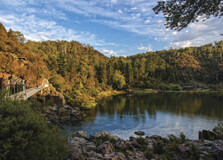
Cataract Gorge Reserve, often simply known as "The Gorge," is one of the most iconic natural attractions in Launceston, Tasmania. Just a few minutes’ walk from the city center, the Gorge offers a stunning combination of rugged cliffs, native bushland, walking trails, gardens, and wildlife—all nestled along the South Esk River. It’s a rare natural formation located so close to an urban area and is loved by both locals and tourists for its beauty and recreational facilities. This unique reserve is a blend of natural wonder and historical development. With attractions like the world’s longest single-span chairlift, Victorian gardens, and a historic suspension bridge, Cataract Gorge Reserve is a must-visit for anyone exploring northern Tasmania. How to Reach Cataract Gorge Reserve, Launceston Cataract Gorge Reserve is located just 1.5 kilometers from Launceston’s city center, making it easily accessible by foot, car, bike, or public transport. By Foot: It’s a 15–20 minute scenic walk from the city center along the river. By Car: Drive via York Street and follow signs to the Gorge; there is parking available near the main entrance. By Bus: Local Metro buses stop nearby, or you can use hop-on-hop-off tourist buses that include the Gorge in their route. By Bicycle: Launceston has bike-friendly paths leading to the reserve. Weather Launceston has a temperate climate, making Cataract Gorge a year-round destination. Summers (December to February) are warm with temperatures ranging between 20–28°C, making it perfect for swimming and picnics. Winters (June to August) are cool, averaging 5–12°C, but still suitable for bushwalks and sightseeing. Spring and autumn are particularly beautiful due to the changing colors of the landscape. Rain can be frequent, so it’s good to check the forecast and wear suitable clothing and footwear. Timings Cataract Gorge Reserve is open to the public 24 hours a day, seven days a week. Entry to the reserve itself is free, and visitors can enjoy walking trails, gardens, and the river anytime. However, specific facilities such as the chairlift, café, and swimming pool have separate operating hours: Chairlift: 9:00 AM – 5:00 PM (hours may vary by season) First Basin Café: Usually 9:00 AM – 4:30 PM Swimming Pool: Open during warmer months (typically December to March) Why Cataract Gorge Reserve is Famous in Launceston Cataract Gorge is famous for its extraordinary setting—a natural river gorge with dramatic cliffs and bushland just minutes from a city. It’s a symbol of Launceston’s connection with nature and offers a peaceful escape within urban surroundings. The Gorge is also home to several unique features, including: The **longest single-span chairlift** in the world. The **historic Alexandra Suspension Bridge** built in 1904. The beautiful **Victorian-style gardens** at the Cliff Grounds. Native wildlife such as peacocks and wallabies. It serves as a hub for community recreation, tourism, and history—all in one picturesque location. Entry and Visit Details Entry to Cataract Gorge Reserve is free. Visitors can explore walking tracks, gardens, and natural features at no cost. However, some attractions and amenities have fees: Chairlift: Approx. AUD $15 one-way or AUD $20 return (adult) Swimming Pool: Free and open during summer Café and Kiosk: Prices vary Boat cruises and guided tours: Extra charges apply The reserve is well-equipped with public toilets, picnic spots, BBQ areas, and plenty of seating. Most areas are accessible for wheelchairs and prams. History and Architecture Cataract Gorge has been a popular destination since the early 1800s. European settlers first recognized its potential as a recreational area in the 1890s. Soon after, the **Cliff Grounds Victorian garden** was developed, turning the natural space into a formal retreat with pathways, imported plants, and ornamental features. One of the most iconic features is the **Alexandra Suspension Bridge**, opened in 1904 and still in use today. The **chairlift**, which opened in 1972, added a modern touch and became a major attraction. The area combines rugged Tasmanian wilderness with historical human design, creating a space that is both scenic and culturally significant. Things to Do at Cataract Gorge Reserve Ride the Chairlift: Enjoy sweeping views over the Gorge on the world’s longest single-span chairlift. Walk the Trails: There are several walking paths, including the **Zig Zag Track** for adventure seekers and **First Basin Walk** for casual walkers. Swim in the Basin: Take a dip in the natural First Basin or the free public swimming pool nearby. Cross the Suspension Bridge: A thrilling walk with views of the river below. Picnic or BBQ: Plenty of grassy spots with public BBQs make it perfect for a family day out. Explore the Gardens: The Cliff Grounds gardens are filled with exotic plants, peacocks, and shaded paths. Wildlife Watching: Spot wallabies, peacocks, and native birds along the trails. Visit the Café: Relax with a coffee or meal while overlooking the basin. Facts and Tips about Cataract Gorge Reserve, Launceston Cataract Gorge is over 160 million years old. The chairlift spans 457 meters with a central span of 308 meters. Free Wi-Fi is available in some parts of the reserve. Peacocks have roamed the gardens since the early 1900s. Wear sturdy shoes for the rocky paths and uneven trails. Bring a picnic and enjoy lunch by the river or gardens. Arrive early in summer months to find good parking and avoid crowds. The reserve is family and pet-friendly (dogs must be on a leash). Cataract Gorge Reserve is truly one of the most unique attractions in Australia. Whether you're visiting for adventure, relaxation, or a scenic photo opportunity, the Gorge offers something for everyone. It’s a perfect representation of Tasmania’s blend of wilderness, history, and community spirit—all within walking distance of Launceston’s city heart.
Explore More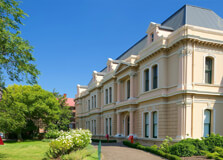
Queen Victoria Museum and Art Gallery
The Queen Victoria Museum and Art Gallery (QVMAG) is one of Launceston’s most treasured cultural institutions. Spread across two sites – the Art Gallery at Royal Park and the Museum at Inveresk – it is the largest regional museum in Australia. QVMAG offers a diverse collection that includes Tasmanian history, visual art, natural sciences, technology, and interactive displays. It is a place where the rich story of Tasmania comes to life through exhibitions, preserved objects, and learning spaces. Whether you’re interested in colonial art, dinosaurs, blacksmithing, or astronomy, QVMAG provides a unique and engaging experience for people of all ages. The museum and art gallery are a perfect combination of education, history, and inspiration in the heart of Launceston. How to Reach Queen Victoria Museum and Art Gallery, Launceston QVMAG has two locations in Launceston: Art Gallery (Royal Park): 2 Wellington Street, Launceston TAS 7250 Museum (Inveresk Precinct): 2 Invermay Road, Launceston TAS 7248 Both sites are easily accessible from the city centre: By Foot: The Royal Park gallery is about a 10-minute walk from the CBD. The Inveresk museum is about 15–20 minutes on foot. By Car: Ample parking is available at both sites, especially at Inveresk. By Bus: Local Metro buses stop near both venues. Check current schedules for routes. By Bicycle: Launceston has bike paths leading to both locations. Weather Launceston experiences mild to cool weather, making visits to indoor sites like QVMAG pleasant all year round. Summer (December to February) has average temperatures of 20–28°C. Winters (June to August) are cooler, averaging 5–12°C. Spring and autumn are ideal times to visit, with mild temperatures and fewer crowds. Since QVMAG is mostly indoors, it’s a great option on rainy or cold days. Both sites are climate-controlled, offering a comfortable environment regardless of outside weather. Timings Both QVMAG sites have the same general opening hours: Open daily: 10:00 AM – 4:00 PM Closed: Good Friday, Anzac Day morning (April 25), and Christmas Day It’s recommended to allocate at least 1.5 to 2 hours for each site to fully enjoy the exhibits. Why Queen Victoria Museum and Art Gallery is Famous in Launceston QVMAG is famous for being the largest regional museum in Australia and one of Tasmania’s premier cultural institutions. It is known for its diverse range of exhibitions that span: Tasmanian colonial history Aboriginal heritage Natural science and geology Modern and classical art Technology and industry A full planetarium experience It plays a crucial role in preserving the cultural and scientific heritage of Tasmania and attracts thousands of visitors annually. The museum is also well-known for its interactive children’s sections, making it a favorite for family outings. Entry and Visit Details Visiting QVMAG is accessible and affordable for all: Entry Fee: Free for general admission (some temporary exhibitions may have a small fee) Accessibility: Both sites are wheelchair-friendly, with ramps and lifts Facilities: Gift shops, restrooms, baby change stations, seating areas Guided Tours: Available for groups and schools by prior arrangement You can start your visit at either site. Many visitors begin at Inveresk for the history and science, then finish at Royal Park for the art collections. History and Architecture QVMAG was established in 1891, making it one of Australia’s oldest museums. The Royal Park site features a classic 19th-century building with heritage architecture. The Inveresk site, however, is a more modern space set within a former railway workshop. This contrast reflects Tasmania’s development—from colonial roots to modern innovation. The Inveresk museum was opened in the early 2000s as part of a redevelopment of Launceston’s industrial precinct. Its design merges old brick structures with contemporary gallery spaces, giving it a unique atmosphere that celebrates both heritage and progress. Things to Do at Queen Victoria Museum and Art Gallery Explore the Railway Workshops: Discover industrial machinery and old rail equipment at Inveresk. Visit the Planetarium: Enjoy educational astronomy shows projected on a dome ceiling (small fee may apply). See Dinosaur Fossils: Learn about Tasmania’s prehistoric past through fossils and geological displays. Admire Colonial and Modern Art: The Royal Park gallery features both historical and contemporary Tasmanian art. Experience Aboriginal Culture: View exhibits that showcase the rich traditions of Tasmania’s First Nations peoples. Hands-On Science: Kids and adults alike will enjoy the interactive science exhibits and discovery areas. Attend Workshops and Events: QVMAG hosts events throughout the year including talks, art classes, and temporary exhibitions. Facts and Tips about Queen Victoria Museum and Art Gallery, Launceston QVMAG was established in 1891 and is over 130 years old. The Planetarium at Inveresk is the only public planetarium in Tasmania. Admission is free, making it one of the best-value attractions in Tasmania. Photography is allowed in many areas but flash may be restricted. There is a strong focus on Tasmanian themes—don’t miss the local history sections. Great place for school excursions and educational outings. The museum and gallery rotate exhibits regularly—each visit can offer something new. Visit the gift shops for local art, books, and educational toys. Plan to visit both sites if you have time—they each offer unique experiences. The Queen Victoria Museum and Art Gallery is more than just a collection of artifacts—it’s a journey through Tasmania’s art, science, history, and people. Whether you’re a curious traveler, a local exploring your city, or a student eager to learn, QVMAG offers a rich, accessible, and engaging experience. It stands as a proud cultural beacon in Launceston and is not to be missed on your Tasmanian adventure.
Explore MoreFun In Gold Coast 3 Night - 4 Days Tour
4 Days/ 3 Night
Gold Coast
Exquisite Australia 8 Nights - 9 Days Tour
9 Days/ 8 Night
Sydney - Cairns - Mykonos
Australian Splendors 12 Nights - 13 Days Tour
13 Days/ 12 Night
Sydney - Cairns - Melbourne - Gold Coast
Pearls Of Queensland 7 Nights - 8 Days Tour
8 Days/ 7 Night
Cairns - Queensland - Gold Coast
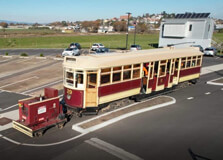
The Launceston Tramway Museum is a unique and fascinating attraction located in Launceston, Tasmania. It offers visitors a chance to step back in time and explore the rich history of Launceston’s tram network. This museum is run by passionate volunteers who have worked hard to restore trams and preserve the stories of the city’s public transport era. The museum is a family-friendly destination that gives you a hands-on experience with real trams and historical displays. At the Launceston Tramway Museum, you can see beautifully restored heritage trams, read about the people who worked on them, and even enjoy a ride on a functioning tram along a short track. It’s a nostalgic experience that connects the past with the present and offers insight into how Launceston once moved around the city. How to Reach Launceston Tramway Museum, Launceston The Launceston Tramway Museum is located in the Inveresk Precinct, near the Queen Victoria Museum and Art Gallery: Address: 2 Invermay Road, Launceston TAS 7248, Australia By Car: There is ample parking available near the Inveresk site, including free and paid spots. By Foot: The museum is just a 15-minute walk from Launceston’s city centre. By Bus: Metro Tasmania buses stop near Invermay Road and the Inveresk precinct. Check local schedules for route details. By Bicycle: Bike paths lead to the Inveresk precinct, and bike racks are available near the museum entrance. Weather Launceston experiences a temperate oceanic climate, which means mild to cool weather throughout the year. The city has four distinct seasons: Summer (December – February): Warm and pleasant with temperatures between 20°C and 28°C. Autumn (March – May): Mild weather, ideal for exploring. Expect 12°C to 20°C. Winter (June – August): Cooler and often cloudy, with temperatures from 3°C to 12°C. Spring (September – November): Fresh and breezy with temperatures between 10°C and 18°C. Since the Tramway Museum is mostly indoors, it can be visited year-round regardless of weather conditions. However, tram rides may be affected by heavy rain, so it’s good to check in advance on wet days. Timings The Launceston Tramway Museum operates on the following schedule: Open: Tuesday, Thursday, and Sunday Hours: 10:00 AM – 4:00 PM Closed: Public holidays and during extreme weather conditions Tram rides are usually available on operating days. It's a good idea to confirm the schedule on their official website or by phone before your visit. Why Launceston Tramway Museum is Famous in Launceston The Launceston Tramway Museum is famous because it preserves an important part of the city’s transport history. Launceston once had a well-developed tram network that operated from 1911 to 1952. The museum is dedicated to keeping that memory alive by showcasing original trams, equipment, and stories from that time. It's also known for its working tram ride – a rare and nostalgic experience that allows visitors to feel what public transport was like in early 20th-century Tasmania. The museum is particularly popular with families, train and tram enthusiasts, and anyone interested in history and technology. Entry and Visit Details Entry Fee: $10 for adults, $5 for children and concession. Family passes are available at $25. Tram Ride: Included in the ticket price on operating days Accessibility: The museum is wheelchair accessible, and assistance is available from volunteers. Facilities: Toilets, seating areas, and a small gift shop with tram-related souvenirs and books. Photography: Allowed and encouraged. Flash may be restricted near sensitive displays. Group bookings and school visits can be arranged in advance. Volunteers are often available to offer guided explanations and answer questions. History and Architecture The Launceston Tramway system began operation in 1911 and ran for over 40 years before ceasing in 1952. The museum was established later by local enthusiasts to preserve the legacy of the trams and the people who operated them. The museum building itself is housed in a former industrial shed, adding to the historic feel of the attraction. The museum includes original tram tracks, old railway tools, uniforms, signage, and detailed records of Launceston’s tram lines. Some of the trams on display have been lovingly restored to their original condition, complete with wooden seats, bell systems, and signage. Things to Do at Launceston Tramway Museum Ride the Heritage Tram: Enjoy a short journey on a restored tram through a section of original track near the museum. View Historical Displays: Learn about tram operations, see uniforms, tickets, and maintenance tools. Watch Restoration Work: Volunteers may be working on restoring old trams, and visitors can watch the process. Interactive Exhibits: Touch and learn exhibits are available for children and families. Read Tramway Stories: Explore the lives of tram drivers, conductors, and passengers through archived photographs and journals. Visit the Gift Shop: Purchase tram-themed memorabilia, books, and locally made crafts. Facts and Tips about Launceston Tramway Museum, Launceston Launceston’s tramway system ran from 1911 to 1952, with over 29 trams operating during its peak. The museum is run entirely by volunteers who are passionate about preserving this piece of local history. Tram No. 29 is one of the key attractions and has been fully restored to working condition. Great for kids and families – children love climbing into the old trams and pretending to be drivers! The museum is located next to the Queen Victoria Museum at Inveresk, making it easy to visit both on the same day. Best visited during sunny weather so you can also enjoy the outdoor tram ride. Bring your camera – the restored trams are great for photos. Allow at least 1–1.5 hours to explore the museum and take a tram ride. The Launceston Tramway Museum is a hidden gem in Tasmania’s cultural landscape. It offers a wonderful mix of nostalgia, education, and fun for visitors of all ages. Whether you’re a history buff, a transport enthusiast, or a family looking for a unique day out, this museum provides an unforgettable experience that celebrates the past while engaging with the present.
Explore More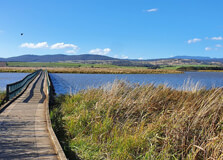
The Tamar Island Wetlands is a serene natural reserve located just a 10-minute drive from Launceston's city center. Spanning over 60 hectares, this area comprises mudflats, lagoons, and islands, offering a unique ecosystem teeming with diverse flora and fauna. It's an ideal spot for nature enthusiasts, bird watchers, and those seeking a peaceful retreat into nature. How to Reach Tamar Island Wetlands, Launceston The wetlands are easily accessible via the West Tamar Highway (A7). From Launceston, head northwest on the A7 for approximately 10 kilometers. The entrance to the Tamar Island Wetlands Centre is well-signposted and offers ample parking facilities. By Car: A straightforward 10-minute drive from Launceston CBD via the A7. By Public Transport: Local bus services operate along the West Tamar Highway; check the latest schedules for specific routes. By Bicycle: The route is bicycle-friendly, with designated bike paths leading to the reserve. Weather Launceston experiences a temperate climate with four distinct seasons: Summer (December - February): Warm and dry, with temperatures ranging from 12°C to 26°C. Autumn (March - May): Mild temperatures and vibrant foliage, averaging between 8°C and 20°C. Winter (June - August): Cool and crisp, with temperatures between 2°C and 13°C. Spring (September - November): Blooming flora and moderate temperatures, ranging from 7°C to 19°C. The wetlands can be visited year-round, but spring and autumn offer particularly pleasant conditions for walking and wildlife observation. Timings The Tamar Island Wetlands Centre operates during daylight hours, typically from 9:00 AM to 5:00 PM. It's advisable to check the official website or contact the center directly for the most current opening times, especially during public holidays or adverse weather conditions. Why Tamar Island Wetlands is Famous in Launceston The Tamar Island Wetlands is renowned for its rich biodiversity and well-maintained boardwalks that allow visitors to immerse themselves in the natural environment without disturbing the habitat. It's a haven for birdwatchers, with numerous species inhabiting the area, and serves as an educational resource highlighting the importance of wetland ecosystems. Entry and Visit Details Entry to the Tamar Island Wetlands is by donation, supporting the maintenance and conservation efforts of the reserve. The site features: An informative Interpretation Centre with displays on local ecology and history. Accessible boardwalks suitable for wheelchairs and strollers. Bird hides for unobtrusive wildlife observation. Picnic areas and rest spots along the trails. Visitors are encouraged to wear comfortable walking shoes and bring binoculars for birdwatching. History and Architecture The Tamar Island Wetlands have a rich history, both ecologically and culturally. The area has been shaped by natural processes and human intervention, including past dredging activities to improve navigation along the Tamar River. Remnants of old dredging equipment can still be seen, serving as historical markers within the landscape. The wetlands are part of the Tamar River Conservation Area, highlighting their significance in regional conservation efforts. Things to Do at Tamar Island Wetlands Walking Trails: Enjoy a leisurely 4-kilometer return walk along the boardwalk to Tamar Island, taking in the scenic views and diverse habitats. Birdwatching: Observe a variety of bird species from designated hides, including black swans, egrets, and cormorants. Educational Programs: Participate in seasonal programs and talks conducted by knowledgeable volunteers and rangers. Photography: Capture the natural beauty of the wetlands, from sunrise vistas to close-ups of wildlife. Facts and Tips about Tamar Island Wetlands, Launceston The wetlands cover over 60 hectares and are home to numerous plant and animal species. It's part of the Tamar Wetlands Important Bird Area, recognized for supporting significant bird populations. Facilities include accessible toilets and seating areas along the trails. Dogs and bicycles are not permitted to protect the sensitive environment. It's advisable to bring insect repellent, especially during warmer months. The boardwalk is exposed; wearing sun protection is recommended. Visiting the Tamar Island Wetlands offers a peaceful and educational experience, showcasing the unique wetland ecosystems of Tasmania. Whether you're a local resident or a traveler exploring Launceston, this reserve provides a tranquil escape into nature.
Explore More
National Automobile Museum of Tasmania
The National Automobile Museum of Tasmania, located in Launceston, is a must-visit destination for car enthusiasts and history buffs alike. Established in 1987 by Geoff and Sylvia Smedley, the museum has grown to become one of Australia's most significant motoring collections. It showcases a diverse range of vehicles, from vintage classics to modern marvels, reflecting the evolution of automotive design and engineering over the past century. How to Reach National Automobile Museum of Tasmania, Launceston The museum is situated at 84 Lindsay Street, Invermay, Launceston, Tasmania 7248. It's conveniently located near the city center, making it easily accessible by various modes of transportation. By Car: Ample free parking is available on-site for cars and motorhomes. By Public Transport: Local bus services operate routes that stop near the museum. Check the latest schedules for specific routes. By Foot: The museum is approximately a 10-minute walk from Launceston's CBD. Weather Launceston experiences a temperate climate with four distinct seasons: Summer (December - February): Warm and dry, with temperatures ranging from 12°C to 26°C. Autumn (March - May): Mild temperatures and vibrant foliage, averaging between 8°C and 20°C. Winter (June - August): Cool and crisp, with temperatures between 2°C and 13°C. Spring (September - November): Blooming flora and moderate temperatures, ranging from 7°C to 19°C. The museum is indoors and climate-controlled, making it a comfortable visit year-round, regardless of weather conditions. Timings The National Automobile Museum of Tasmania operates daily, with the following hours: Regular Hours: 9:00 AM – 5:00 PM Winter Hours (June - August): 10:00 AM – 4:00 PM Closed: Christmas Day Why National Automobile Museum of Tasmania is Famous in Launceston The museum is renowned for its extensive and diverse collection of automobiles and motorcycles, representing over a century of motoring history. It offers visitors a unique opportunity to explore rare and significant vehicles, some of which are not found in any other collection. The museum's dedication to preserving and showcasing automotive heritage has made it a prominent cultural attraction in Launceston. Entry and Visit Details Admission fees are as follows: Adults: $18.00 Seniors: $15.00 Children under 16: $9.00 Family (2 adults and children under 16): $45.00 Adult Annual Pass: $45.00 The museum offers free parking and is wheelchair accessible. Facilities include restrooms, a gift shop, and an enquiry desk. Photography is allowed, making it a great spot for capturing memories. History and Architecture Founded in 1987 by Geoff and Sylvia Smedley, the museum was established to preserve and celebrate the history of motoring. Geoff Smedley, an internationally renowned motor racing engineer, played a pivotal role in restoring and displaying some of the world's rarest and finest cars. In September 2019, the museum relocated to a new purpose-built facility at 84 Lindsay Street, providing a spacious and modern environment to house its growing collection. Things to Do at National Automobile Museum of Tasmania Explore the Exhibits: View an impressive array of vehicles, including opulent Rolls-Royces, elegant Bentleys, classic Jaguars, and unique motorcycles. Visit the Gift Shop: Browse one of the largest automobilia gift shops in the country, offering model cars, books, memorabilia, and more. Attend Special Exhibitions: The museum regularly updates its displays and hosts special exhibitions, providing fresh experiences for repeat visitors. Educational Opportunities: Learn about the evolution of automotive design and engineering through informative displays and exhibits. Facts and Tips about National Automobile Museum of Tasmania, Launceston The museum's collection spans over 100 years of automotive history, featuring both traditional and contemporary marques. It houses some unique exhibits not found in any other collection. The facility is fully accessible, catering to visitors with mobility needs. Located across the road from the Silo Hotel and Riverbend Park, it's an ideal addition to a day of local sightseeing. Plan to spend at least 1-2 hours to fully appreciate the exhibits. Check the museum's official website or contact them directly for the latest information on exhibitions and events. The National Automobile Museum of Tasmania offers a captivating journey through the history of motoring. Whether you're an automotive enthusiast or simply curious about the evolution of transportation, the museum provides an engaging and educational experience for visitors of all ages.
Explore More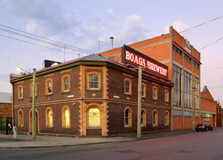
Boag’s Brewery, officially known as J. Boag & Son, is one of Launceston’s most iconic attractions and an important part of Tasmania's rich brewing heritage. Located in the heart of Launceston, this historic brewery dates back to 1881 and continues to produce some of Australia's most loved beers. The brewery is not only famous for its beverages but also for its heritage-listed buildings, engaging guided tours, and deep-rooted history in the community. A visit to Boag’s Brewery offers an authentic Tasmanian experience that blends tradition, craftsmanship, and local culture. How to Reach Boag’s Brewery, Launceston Boag’s Brewery is conveniently located at 39 William Street, Launceston, Tasmania. It's easily accessible by multiple transport options: By Car: Launceston is a compact city, and the brewery is just a few minutes’ drive from most central accommodations. Paid and free parking options are available nearby. By Bus: Local Metro Tasmania buses service the area, with stops close to the brewery. The central bus station is also within walking distance. By Foot: If you're staying in the city centre, it’s a pleasant and short walk to the brewery. By Taxi or Ride Share: Services like Uber and local taxis are readily available throughout Launceston. Weather in Launceston Launceston experiences a temperate maritime climate with distinct seasons. The best time to visit depends on your preferences: Summer (Dec-Feb): Warm and dry, ideal for walking tours. Temperatures range from 12°C to 26°C. Autumn (Mar-May): Mild weather with beautiful autumn foliage. Average temps range between 8°C and 20°C. Winter (Jun-Aug): Cool and often foggy mornings, but great for indoor attractions like the brewery. Temps can drop to 2°C at night. Spring (Sep-Nov): Pleasant temperatures with blooming gardens and fewer crowds. Timings of Boag’s Brewery Boag’s Brewery is open for public tours and visits throughout the week. Tour timings are subject to change, so it’s advisable to confirm before your visit. Opening Hours: Monday to Sunday, 10:00 AM to 4:00 PM Guided Tour Times: Usually offered at 11:00 AM, 1:00 PM, and 3:00 PM Duration: Around 90 minutes per tour Booking: Advance booking is highly recommended, especially during weekends and holidays. Why Boag’s Brewery is Famous in Launceston Boag’s Brewery is a cornerstone of Launceston’s identity. It is renowned for its historic significance, award-winning beers, and commitment to tradition. The brewery has won numerous national and international awards and is especially famous for its flagship beer, James Boag’s Premium Lager. Boag’s has remained an integral part of the Tasmanian community for over a century, and its name is synonymous with quality and heritage. The brewery also plays a role in local events and contributes significantly to Tasmania’s tourism and economy. Entry and Visit Details Visiting Boag’s Brewery is an engaging experience that offers more than just a look at how beer is made. Here’s what you need to know: Entry Fee: Adults: $33 | Concession: $28 | Children (5-17): $15 Tour Includes: A guided walk through the brewing process, access to historical exhibits, and a tasting session with a selection of Boag’s finest beers and local Tasmanian cheeses. Accessibility: The brewery is wheelchair friendly and offers accessible restrooms and facilities. Children Policy: Kids are welcome on tours but must be accompanied by an adult. Beer tastings are strictly for those over 18 years. History and Architecture Founded in 1881 by James Boag and his son, the brewery has remained one of Tasmania’s leading beverage producers. The original buildings are well-preserved and form part of Launceston’s architectural heritage. The brewery features Victorian industrial architecture with brickwork, large wooden beams, and original brewing equipment on display. The structures are listed as heritage properties, and care has been taken to maintain their original charm while upgrading facilities for modern use. Things to Do at Boag’s Brewery Join a Brewery Tour: Learn about the brewing process from malt to bottle, and hear fascinating stories from over 140 years of operation. Beer Tasting: Taste a range of Boag’s beers, including their Premium Lager, Draught, and seasonal brews. Explore the Museum: View historical brewing equipment, photographs, and marketing memorabilia. Visit the Retail Store: Buy exclusive merchandise, local gifts, and of course, Boag’s beer. Relax at the Tasting Bar: Unwind with a fresh pour in a cozy setting, perfect for beer lovers. Facts and Tips about Boag’s Brewery The brewery has been operating since 1881 and is one of Australia's oldest continually operating breweries. Boag’s Premium Lager has won several awards at international beer competitions. The facility uses water sourced from the pristine Tasmanian highlands, contributing to the quality of its beer. Wear comfortable shoes for the tour, as it involves walking and standing for an extended period. Photography is allowed during most parts of the tour, but some areas may restrict flash use. Arrive 15 minutes early to check in and enjoy the visitor center before your tour begins. Tour participants must show valid ID for beer tastings. Whether you're a history buff, a beer enthusiast, or just looking to experience something uniquely Tasmanian, Boag’s Brewery offers an informative and enjoyable outing. Its blend of rich tradition, quality brews, and inviting atmosphere makes it a must-visit destination in Launceston.
Explore More
The Newcastle Memorial Walk is one of the most iconic attractions in Newcastle, New South Wales, Australia. Opened in 2015 to commemorate the centenary of ANZAC (Australian and New Zealand Army Corps) troops landing at Gallipoli in World War I, this scenic clifftop walkway is both a touching war memorial and a beautiful coastal walk. Spanning 450 meters, the elevated bridge structure offers panoramic views of Newcastle’s coastline, beaches, and cityscape. Whether you're interested in history, enjoy walking, or just want to experience breathtaking views, the Newcastle Memorial Walk is a must-visit. How to Reach Newcastle Memorial Walk, Newcastle The Newcastle Memorial Walk is easily accessible from the city centre and popular local areas: By Car: You can drive to Strzelecki Lookout at the top of Memorial Drive, where parking is available. From there, the walk begins and continues toward Bar Beach. By Public Transport: Local buses from Newcastle Interchange stop near King Edward Park and Memorial Drive. From there, a short walk uphill will lead you to the entrance of the walk. By Foot or Bicycle: The walkway connects with local cycling and pedestrian paths. It's a popular route for joggers and walkers from Bar Beach and the city centre. Weather in Newcastle Newcastle experiences a mild coastal climate that makes the Memorial Walk pleasant to visit year-round: Summer (Dec–Feb): Warm and sunny, average temperatures between 18°C and 27°C. Ideal for morning or late afternoon walks to avoid peak sun. Autumn (Mar–May): Mild and comfortable, great for sightseeing and fewer crowds. Winter (Jun–Aug): Cool with temperatures ranging from 8°C to 18°C. Clear skies and fresh sea air make it perfect for a brisk walk. Spring (Sep–Nov): Pleasant weather with blooming flora and refreshing breezes. Timings of Newcastle Memorial Walk The Newcastle Memorial Walk is open 24 hours a day, 7 days a week. However, it's best visited during daylight hours for safety and to enjoy the stunning views. Recommended Hours: Sunrise to Sunset for ideal lighting and safety. Evening Walks: Safe but carry a flashlight or use mobile lights if walking after dark. Sunrise/Sunset: These times offer the most picturesque scenes and photo opportunities. Why Newcastle Memorial Walk is Famous in Newcastle The Newcastle Memorial Walk is a symbolic and emotional tribute to the soldiers of World War I, especially the ANZAC troops. It’s not only a significant war memorial but also an engineering marvel perched above the city’s stunning coastline. Visitors are drawn to its dual purpose—honouring the past while offering one of the best panoramic walks in the region. The silhouettes of soldiers etched along the walkway create a moving experience, blending history with nature and making it one of the most beloved destinations in Newcastle. Entry and Visit Details Entry Fee: Free of charge. The Memorial Walk is open to all visitors and does not require a ticket or reservation. Accessibility: The walkway is wheelchair accessible from the Strzelecki Lookout side. Some parts are slightly steep but generally manageable. Pets: Leashed pets are allowed. It's a popular walking route for local dog owners. Parking: Free and metered street parking is available near both entry points—Strzelecki Lookout and Bar Beach. History and Architecture Constructed as part of the ANZAC Centenary commemorations, the Newcastle Memorial Walk was officially opened on April 24, 2015. It was built by BHP Billiton and gifted to the people of Newcastle. The structure pays tribute to the 11,000 Hunter Valley enlistees who served in World War I, with their names laser-cut into steel panels along the bridge. Architecturally, the walkway is a 160-meter-long bridge made from stainless steel and reinforced concrete. It follows the coastal cliffs from Strzelecki Lookout and connects to the Bathers Way Walk. The bridge’s design is modern yet respectful, featuring soldier silhouettes and interpretive panels. The stunning combination of steelwork and natural surroundings makes it a standout structure in both form and function. Things to Do at Newcastle Memorial Walk Take in the Views: Enjoy sweeping views of the Pacific Ocean, Newcastle Beach, Bar Beach, and beyond. Photography: A perfect spot for sunrise and sunset photos, with steel silhouettes adding depth and emotion to pictures. Fitness Walk: A great place for jogging or a morning walk as part of the longer Bathers Way trail. Learn History: Read the stories of local soldiers and explore the interpretive plaques about Newcastle’s military contribution. Whale Watching: During migration seasons (May to November), the walk is a great place to spot humpback whales. Facts and Tips about Newcastle Memorial Walk The walk was built using 64 tonnes of stainless steel, much of it manufactured in Newcastle. Names of over 10,000 World War I enlistees from the Hunter region are engraved on the steel panels. Early mornings are less crowded and offer the best light for photography. There are no public toilets directly on the walk, but nearby Bar Beach and King Edward Park have facilities. Wear comfortable shoes, especially if planning to continue onto the longer Bathers Way trail. Carry water, as there are limited places to refill on the walk itself. Look for information boards that tell more about Newcastle’s involvement in WWI and WWII. The Newcastle Memorial Walk is more than just a scenic spot—it's a place of remembrance, reflection, and connection to nature. Whether you’re a history enthusiast, nature lover, or casual visitor, this impressive walkway offers a moving and unforgettable experience. Add it to your Newcastle itinerary for a journey through beauty, bravery, and Australian heritage.
Explore More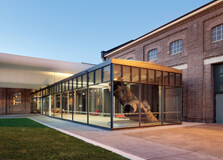
Located in the heart of Newcastle, New South Wales, the Newcastle Museum is one of the city's top attractions. This family-friendly museum offers an engaging and informative experience for all ages. With a focus on the region’s history, science, and innovation, the museum showcases Newcastle’s transformation from a coal mining and steel manufacturing hub to a modern, vibrant city. How to Reach Newcastle Museum, Newcastle Newcastle Museum is conveniently located at 6 Workshop Way, Honeysuckle, which is close to the city centre. You can reach the museum by multiple means: By Train: The museum is a short walk from the Newcastle Interchange Station. The station is well-connected with other major cities like Sydney. By Bus: Several local buses stop nearby, making it easy to reach from different suburbs within Newcastle. By Car: Visitors can drive to the museum, with metered parking available in the surrounding area. By Light Rail: The Newcastle Light Rail stops at Honeysuckle Station, which is just a few minutes' walk from the museum. Weather in Newcastle Newcastle has a temperate climate with warm summers and mild winters. The average summer temperature ranges from 20°C to 30°C (68°F to 86°F), while in winter, it ranges between 8°C and 18°C (46°F to 64°F). Rainfall is fairly consistent throughout the year, so it's a good idea to check the weather forecast before visiting. Timings of Newcastle Museum The museum is open from Tuesday to Sunday, between 10:00 AM and 5:00 PM. It is closed on Mondays, Good Friday, Christmas Day, and Boxing Day. It’s best to check the official website for any special closures or extended holiday hours. Why is Newcastle Museum Famous? Newcastle Museum is renowned for its rich historical exhibits, interactive science displays, and its role in preserving the cultural heritage of the region. One of the key attractions is the 'Supernova' science centre, which provides hands-on science experiences for children and adults alike. The museum is also known for its thoughtful exhibitions on Aboriginal culture, steelworks history, and local innovations. Entry and Visit Details General entry to the Newcastle Museum is free, making it an accessible destination for everyone. However, some special exhibitions and events may require a paid ticket. Visitors should allow at least 1.5 to 2 hours to explore the museum fully. Group tours and school excursions are available and should be booked in advance. History and Architecture of Newcastle Museum The museum is housed in a beautifully restored 19th-century railway workshop. Originally part of the Honeysuckle Railway Workshops, the site reflects the city’s industrial past. The architecture blends historical charm with modern elements, creating a unique atmosphere that enhances the visitor experience. The museum opened at its current location in 2011, having moved from its original home in the former Castlemaine Brewery building. The building’s layout preserves its industrial heritage with large open spaces, high ceilings, and exposed brickwork. These architectural features create a perfect backdrop for the museum’s diverse collections and exhibitions. Things to Do at Newcastle Museum There’s a lot to see and do at Newcastle Museum. Some highlights include: Supernova: An interactive science centre that offers hands-on experiments and educational fun for children and families. The Fire and Earth Exhibit: This exhibit highlights Newcastle’s coal mining and steel-making history, featuring original equipment and immersive displays. A Newcastle Story: A permanent exhibition that takes visitors through the city’s past, from early Aboriginal culture to modern development. Special Exhibitions: The museum regularly hosts temporary exhibitions featuring contemporary art, science, and history topics. Events and Workshops: The museum hosts community events, educational programs, and school holiday workshops throughout the year. Interesting Facts About Newcastle Museum The museum was originally established in 1988 and moved to its current location in 2011. It is situated in a heritage-listed site, which once served as a key industrial workshop during Newcastle’s steel era. The museum is committed to sustainability and includes energy-efficient designs and recycling initiatives in its operations. It showcases a significant collection of Aboriginal artefacts and stories from the Awabakal and Worimi people. The Fire and Earth exhibit features a recreated underground coal mine experience. Tips for Visiting Newcastle Museum Plan Ahead: Check the museum’s website for current exhibitions and events so you can make the most of your visit. Visit Early: Arriving in the morning helps avoid crowds, especially during school holidays and weekends. Family Friendly: Bring your children along—there are plenty of kid-friendly exhibits and activities. Photography: Most areas allow photography, but check for signs and restrictions in temporary exhibits. Accessibility: The museum is wheelchair accessible and provides facilities for people with disabilities. Combine with Nearby Attractions: The museum is close to the waterfront, cafes, and the Honeysuckle precinct, making it easy to plan a full day out. Conclusion The Newcastle Museum is more than just a place to learn about history—it’s a dynamic space that celebrates culture, innovation, and community. Whether you're a local resident or a tourist, the museum offers a rich and interactive experience. With free entry, educational displays, and its central location, it’s a must-visit destination in Newcastle.
Explore More